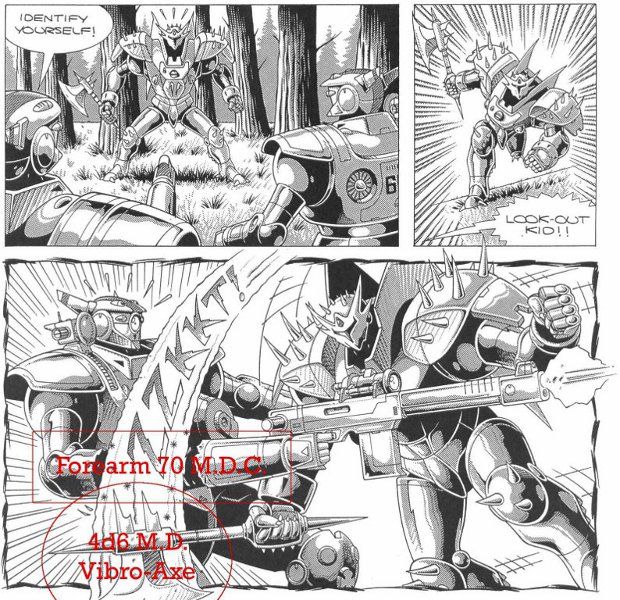Rifts Space by Alien Rope Burn
If so desired, the Game Master can rule that no character in Mutants In Orbit has any additional mutations or changes, and play it as a straight, hard, science fiction background with ordinary human characters.
Original SA post "Gosh, I want to play an anthropomorphic mouse-""Okay."
"- that's can shoot eye lasers-"
"Okay."
"- is a cosmonaut-"
"Okay."
"- and is a roided-up steroid super soldier with only six years to live."
"That's amazingly specific, but have we got the game for you!"
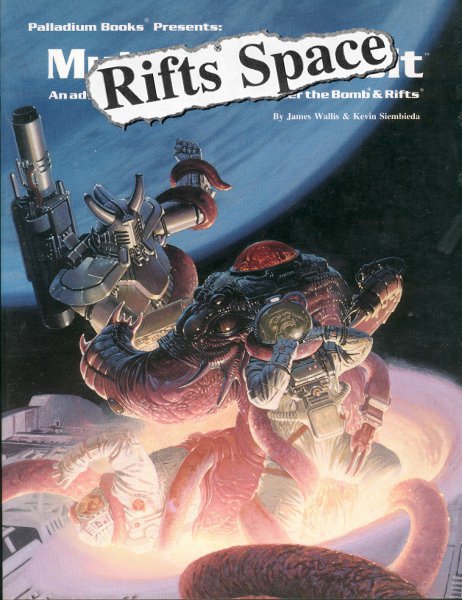
This monster does not actually appear in this book.
Rifts® Space Part 1: "If so desired, the Game Master can rule that no character in Mutants In Orbit has any additional mutations or changes, and play it as a straight, hard, science fiction background with ordinary human characters."
Yes, we actually goofed. This book, Mutants in Orbit , came out before Rifts World Book Three: England and Rifts World Book Four: Africa , but it was forgotten in the parade line of Rifts books. So here it is.
Mutants in Orbit is a oddity amongst Rifts material in that it is actually billed firstly as a supplement for the After the Bomb campaign setting for Teenage Mutant Ninja Turtles and Other Strangeness . After the Bomb was Palladium's first post-apocalypse setting, released well before Rifts . However, this book has extensive Rifts material adapting it to that setting, and that's what I'll be covering here. I'll only be covering the After the Bomb material as it's adapted to Rifts . Trying to cover the After the Bomb portions would require me to cover Teenage Mutant Ninja Turtles & Other Strangeness and After the Bomb , and that's a tall order.
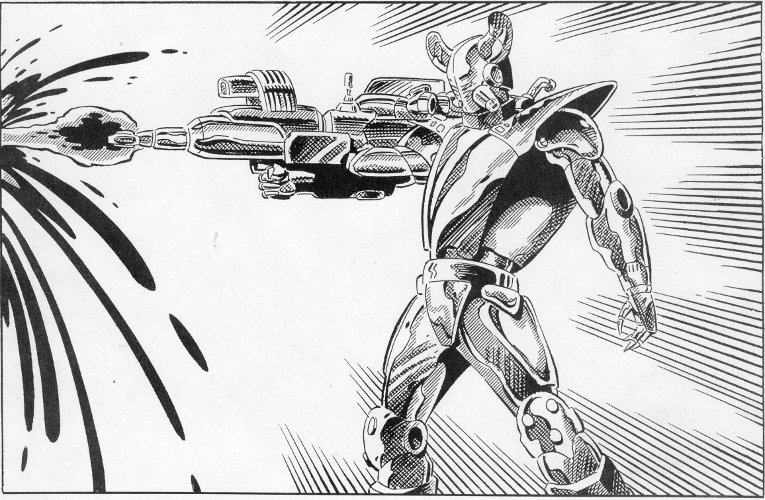
A Glitter Boy battles a baby. (Baby not pictured.)
But to sum up After the Bomb , it's a setting where radiation has mutated a decent chunk of Earth's animal life into sentient, humanoid animal-people. Somehow it did this in space, too. Though the anthropomorphics are subdued for the Rifts setting, they are still an influence on things. The Rifts setting still has the anthropomorphics, but less of them, making humans dominant instead of furries. Of course, there's the issue that if you want the rules for them, you'd need a copy of Teenage Mutant Ninja Turtles & Other Strangeness or Heroes Unlimited , so I won't be dwelling on them too much. This book also has a third game it can be used with: Heroes Unlimited , and it's uncommonly flexible for a Palladium supplement in that it suggests means to change the setting to make it more viable - adding space stations to a superhero world, or just using the giant insects later in the book as a supervillain threat. It also seriously suggests the idea of removing all the mutations and superpowers and trying to use it for hard sci-fi.
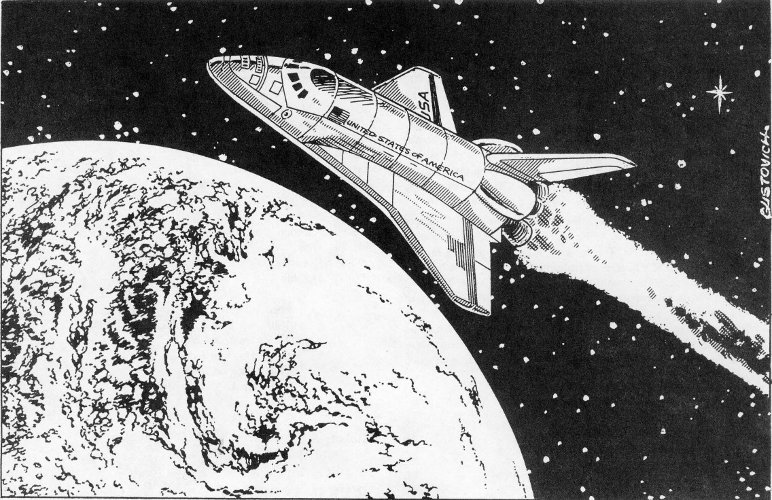
300 years in our future and still using designs from 30 years in our past, apparently?
Of course, this flexibility comes from a different author from Siembieda. Though Siembieda does a good chunk of the Rifts text, the After the Bomb material comes from James Wallis, who would later head Hogshead Studio, as well as write storytelling games like Once Upon a Time and The Extraordinary Adventures of Baron Munchausen . Is it a secret storygamer conspiracy to undermine Palladium Books?* The introduction tells us that we have space colonies up in orbit, as well as pre-Rifts companies like the KSL Corporation (creators of the Glitter Boy) and the Cyberworks Network (creators of ARCHIE-3). And they're jerks!
Next: Your furry astronaut adventure begins here!
* No.
This power can be given to ALL mutant insects if so desired; kinda nasty (I like it).
Original SA post
Rifts® Space Part 2: "This power can be given to ALL mutant insects if so desired; kinda nasty (I like it)."
Rifts characters in space are done slightly differently than normal. Instead of picking from a list of classes, first you pick an origin, mostly referring to your station of birth. It's recommended that PC groups come form the same origin, since all of the stations are engaged in a cold conflict with each other. It notes that you can't come from the Moon, Mars, or asteroids, because... reasons? This will make increasingly less sense as time goes on. It also notes that if you roll a Physical Beauty of 3 or 4, you automatically come from Outcast Station and get to roll once on the mutation tables for an unusual characteristics. Nobody is ugly naturally anymore!
Origins can be rolled randomly or selected, but it recommends letting folks select them instead. The origins are:
-
Laika Station:
Aka Russia station. You get to be poor, but get a bonus on a ton of skills like mechanical, piloting, and espionage skills. You also have a 50% chance of being allowed to "borrow" a vessel (each according to his need and all that).
-
Freedom Station:
Aka America + Canada. YOu get zero gravity and oxygen conservation skills for free. and a bonus on computer and electrical skills. You're also relatively rich.
-
Yuro Station:
Aka EU Station. You get zero gravity and oxygen conservation skills, and a big bonus on communications, science, and technical skills.
-
Outcast Station:
Aka Mutant Station. You get zero gravity combat, vacuum survival, and one weapon skill of your choice, and get a bonus on rogue skills.
-
Moon Base:
Wait, didn't it just say you
couldn't
come from here? Confusing! Anyway, this means you work with the Cyberworks corporation (which you may remember from the
Rifts Sourcebook
). You get zero gravity and mining skills for free, and a bonus on physical skills (actually often irrelevant, because most physical skills aren't rolled). However, you have a 40% chance of getting a suit of Samurai or Mikado power armor! Yet, they are not Japanese-themed.
-
Freebooter:
You come from nowhere, man! Zero gravity and basic mechanics as bonus skills, and then you get a bonus on pilot and spatial skills. Also you have a 50% chance of owning a small spaceship. It notes here that it's a good idea for a group of characters to have access to a spaceship. (But getting a spaceship is random, so... eh? Eh!)
We're referred to a list of occupations used in After the Bomb character creation as well. This is a random table, but it recommends players be allowed to select instead. I get the impression Wallis didn't want tables, but Palladium is as Palladium does...
-
Astrologer O.C.C.:
Basically, a vagabond with less skills, but automatic minor psionics and a small I.S.P. boost. They also get the new Astrology skill, which is hinkey, unreliable, and not the best thing to hang a character concept on. We'll get to it in a bit.
-
Cyberjack O.C.C.:
A city rat with considerably fewer skills who specializes in computers. They get the new cyberjacking skill, which lets them directly plug into computers.
-
Defense Officer O.C.C.:
A really stripped-down version of the CS Military Specialist, but they're experts in zero gravity combat and using colony defense weapons.
-
Energy Specialist O.C.C.:
Somebody who works with power generation systems; apparently this gets you a fair amount of status on stations. Otherwise, they're operators with less skills.
-
Guard O.C.C.:
Basically just local muscle for freebooters (space truckers) or bodyguards for high-ups. Like the vagabond, only with fewer skills.
-
Jack Of All Trades:
Also known as "JOATs" (no, really), these folks are drifters, and not well-liked because of their percieved unreliability. Still, they do a lot of crap work. They're considered "a version of a vagabond operator or scientist", which makes no sense, since that could be any one of three classes.

-
Medic O.C.C.:
You get to play the Body Doc O.C.C. with its normal skills, which is... uh, a ridiculous number of skills compared to all the O.C.C.s we've seen so far. Yes,
 we have balance issues already.
we have balance issues already.
-
Miner O.C.C.:
A vagabond with less skills, but the new mining and zero-g skills. They're not well liked because they're gruff dwarfy types, but they're necessary to the colonies' survival.
-
Space Pilot O.C.C.:
Another vagabond-based class with fewer skills, this time focusing on spaceship piloting. Every kid wants to grow up to be these guys, but they're just working schmoes like everybody else.
-
Research Scientist O.C.C.:
People really respect science... in space! They're treated just like rogue scientists, which gives the same issue as the Medic O.C.C. - you get a lot more skills than everybody else.
-
Salvage Expert O.C.C.:
A crummier version of the rogue scientist, but with a focus on salvaging, recycling, and zero gravity activities. They also get a free spacesuit and a 35% chance to own a ship.
-
Freebooter O.C.C.:
A mercenary or adventurer (or both). You can pick from the city rat, "wilderness space scout", headhunter, operator, or vagabond O.C.C. from
Rifts
, only you get a small bonus to the new contact skills. You also get a free spacesuit, laser pistol, and 25% chance to own a "small shuttle".
-
Ship Engineer O.C.C.:
A crummy version of the engineer who gets a free spacesuit and tool kit. They focus on fixing and building spaceships, and get a fair amount of status.
-
Survival Systems Technician O.C.C.:
Another high-status occupation, on account of keeping everybody alive. They get to be operators with reduced skills, but an emphasis on new skills like hydropnics, recycle, oxygen systems, etc. Also, free suit.
-
Trader O.C.C.:
Hated and loved, because most stations hate admitting they aren't self-sufficient, but also rely on these folks.
Space truckers.
They get to be operators with less skills but with a pilot emphasis, a free energy weapon, space suit, and a 58% chance of getting a medium shuttle.

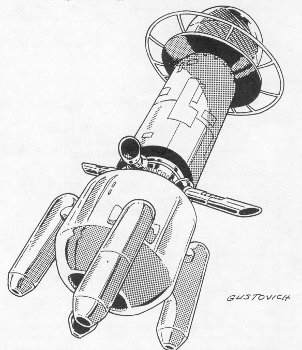
Satellite? Space station? Sex aid? You decide!
Most other character options are like in Rifts , but there is one other difference: mutations, on account of cosmic rays or whatever. This (presumably) replaces the human psionic tables from the corebook.
-
You have a 33% chance to have no mutations. If you have no mutations and are from Outcast Station, you get to be a mutant genius... so much for not being a mutant! Mutant genii can take classes from other games to represent being a genius, including: hardware training (
Heroes Unlimited
), genius or psi-mechanic (
Beyond the Supernatural
), or a gizmoteer or "gizoid" (
Ninjas & Superspies
). If you only own
Rifts
, well, screw you, cheapskate! You also get four (4!) rolls on the unusual characteristic table as a genius, and a 90% chance of getting a few brainy psionic powers.
-
You have a 33% chance to have psionics. These are actually pretty buff selections of psychic powers, with over half the table rolls including super psionic powers. At the top end it lets you select the Burster R.C.C. if you want from the
Rifts
core, which seems like a
bad talent to develop in space
, since that makes you the oxygen destroyer, though it could be useful to be a
living bomb
. (Didn't it just say we couldn't take that class? Oh well...) It's also possible to start with more super psionic powers than
even a mind melter
(you just don't get more as you level)... and be a rogue scientist or wilderness scout on top of that! Yeesh. Game balance - it's what's for dinner! If you're from Outcast Station you get extra psionic powers.
-
The final 34% is left for characters to get superpowers! You get 2-5 minor abilities, or 1-2 minor powers and 1-2 major powers. Unfortunately, you need a copy of
Heroes Unlimited
and
the Rifts Conversion Book
to really make use of this. Alternately, they have a quickie list of superpowers for mutant animals listed earlier, and you can roll twice on that. If you're from Outcast Station you get a bonus power.
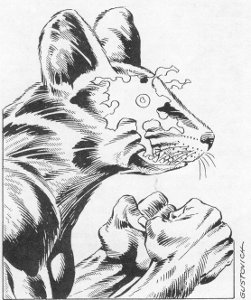
Super-constipation is not a listed power, however.
So, we have some superpower lists. Very grab-baggy. Here's my top ten examples:
-
Increased (Attribute):
Adds 1d6 to a single attribute. Useful at high levels, pointless if your attribute is low to begin with.
-
Double-Jointed:
Yup. This counts as a superpower. Really. THere's an improved version later own called "Plastic Bones".
-
Body Freeze:
There's a chance equal to (Physical Endurance x 5%) that you can be frozen (including in space) and not die. Woo! That means you only don't die half the time. It suggests this power be given to all mutant insects.
-
Increase Size:
Can double size. No idea what happens if you do this in a spacesuit.
-
Low Oxygen Use:
You only use a third of the normal oxygen - one of a series of space-specific powers like Oxygen Retention or Hibernation.
-
Invulnerability:
You're immune to damage. Period. You can take a boom gun bullet to the nethers and come up smiling. Poisons and toxins do half damage, but you can still be suffocated. Magic and psionics affect you normally... though you can also have the Mind Block power, and blow off a lot of psionic effects...
-
Peripheral Vision:
You have
bug eyes
and
everybody envies you
because
you can see your own ass
.
-
See the Unseen:
You get bonus colors ("30% more than the average human"), ultraviolet, infrared, and "polarized vision". You can also see auras and invisible stuff. Bet you wish you could
see your own ass, though!
-
Fur Armor:
It's fur! It gives minor S.D.C. armor, repels water, and reduces cold and radiation (?!) damage by half.
-
Sucker Feet:
If you're not lucky enough to roll Adhesion, you could end up with Adhesion 1that only works with your shoes off (i.e. not in space, where you need it the most).
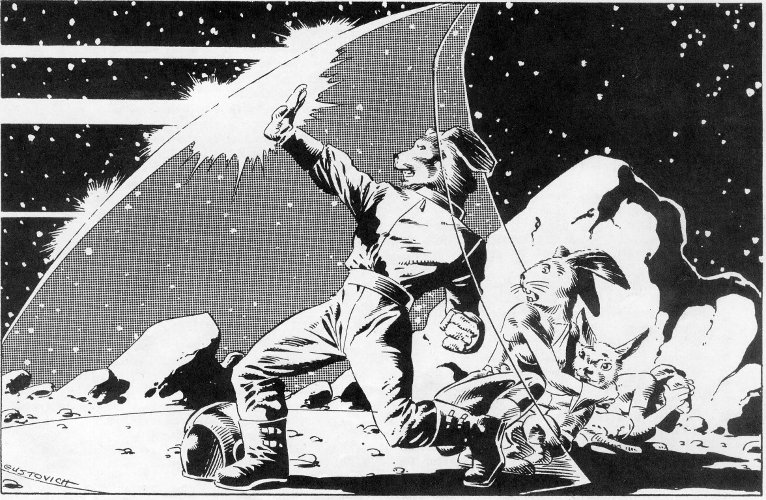
The art is space furries all book long, really.
Oh, and there's conventional stuff like bio-manipulation (a Palladium favorite), laser eyes, flight, etc. Then, we have unusual characteristics like:
-
Blotchy skin!
-
Gorilla arms!
-
No body hair!
-
Huge ears!
-
A walrus face!

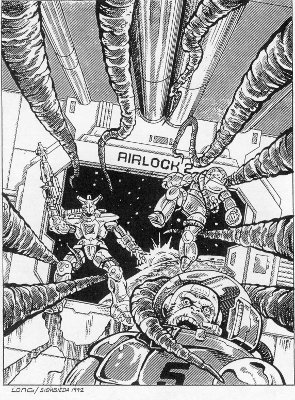
There are no tentacled monsters in this book, as it turns out.
Lastly, for character creation, we get new skills... which is a real issue, because that means skill list bloat - already an issue of most Palladium games - is in full effect. Here's some examples:
-
Astrology:
You can get vague answers about the future! Your chance of success is very low, though (11-32% to start, generally), and increases very slowly. Mostly just flavor.
-
Combat, Zero Gravity or Combat, Gravity:
Yes, this makes you buy hand-to-hand skills
twice
, once for zero-g and once in gravity. (This does not include moving in zero-g, either - that's the Movement: Zero Gravity skill!)

-
Contacts:
You can roll to see if you've heard of somebody!... only the base skill percentage is 6% + 2% per level. Oh, and if you roll under ten percent of
that
percentage, you've met them personally. So by 15th level, you have a 3% chance of knowing a stranger personally. Whee!
-
Drive Repair:
There are four space drives: chemical drive, ion drive, plasma drive, and traction drive. They all require different repair skills. Enjoy!
-
Jury-Rig:
Lets you get equipment back into working order. It doesn't let you reuse old components, that's the Recycle skill...
-
Pilot Spacecraft:
Lets you fly a spacecraft. Doesn't cover flying in combat or stunts - that's Pilot Spacecraft: Advanced! Or navigation - that's Interplanetary Navigation. Or using weapons - that's Ship-to-Ship Combat. Or flying a solar vehicle, that's Pilot Yacht...
-
Vacuum Survival:
Lets you survive longer in space unaided, normally a number of seconds equal to your Physical Endurance. Once this skill maxes out at 15th level, you can last... oh... a minute and a half in space!

Next: Space, and why it sucks.
The Coalition's last attempt to enter space was 76 years ago. They too have forsaken space and took great delight in Triax's subsequent failure.
Original SA post
Rifts® Space Part 3: "The Coalition's last attempt to enter space was 76 years ago. They too have forsaken space and took great delight in Triax's subsequent failure."
Now, here we start to get into background. Though I usually present a book page-by-page, there's an issue where the After the Bomb material is presented first, then the Rifts adaptation is done after. Instead, I'm merging the two - bear in mind this is a lot harder to absorb from the book itself because you have to flip back and forth to get all the setting bits. A sane layout person would put them next to each other, but there's even a full chapter's worth of material (roughly speaking, Palladium doesn't do chapters, as you may recall) separating the two.
So, to the folks stuck on Earth, space is now a mystery. Both the Coalition and Triax have tried to send stuff into orbit, only to have it vanish. There are three theories:
-
There are Pre-Rifts killer satellities that blow up anything that reaches orbit.
-
There's a ring of debris in counter-orbit that shreds anything flying up.
-
There's a dimensional envelope that surrounds that planet that sends anything leaving it to another dimension.
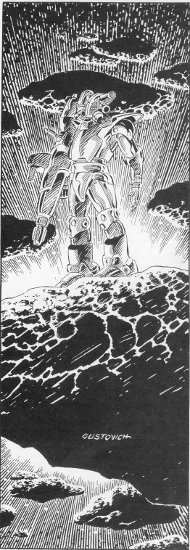
"Of course, an sluggish, bipedal tank: the perfect space weapon!"
Most of the survivors figured the world had basically ended after all the disasters that hit. One in five (really?) committed
 the night of the disaster. Another one in five died from injuries relating to the cataclysm. And finally, one in ten died from pure apathy and ennui. Bummer! Then some more people committed suicide or gave up as the weeks wore on. Finally, the survivors started rebuilding, and after the stations got back in contact with each other, they cooperated to get back into business.
the night of the disaster. Another one in five died from injuries relating to the cataclysm. And finally, one in ten died from pure apathy and ennui. Bummer! Then some more people committed suicide or gave up as the weeks wore on. Finally, the survivors started rebuilding, and after the stations got back in contact with each other, they cooperated to get back into business.
Some tried to return to Earth. They were never heard from again. Dun dun dun!

Life in Orbit
Things are busy in orbit, as people mine asteroids for ice, rely on jury-rigged equipment (they use every piece of the toaster), and most stations have very fixed roles for people they are expected to stick to and live up to, and work is very hard. Shirkers or parasites get "spaced" or exiled. There are occasional short conflicts and the like that take lives, as well.
Space, in general, sucks, and is so big there are plenty of uncharted objects, and anything lost out in space is basically lost forever. Solar winds can bombard the stations with radiation, micro-meteroids can punch through things, unprotected life can mutate, and so on, and you can't predict for anything. The space stations which are the core of the setting are beyond the safety of the Van Allen Belt, so radiation is a real issue.
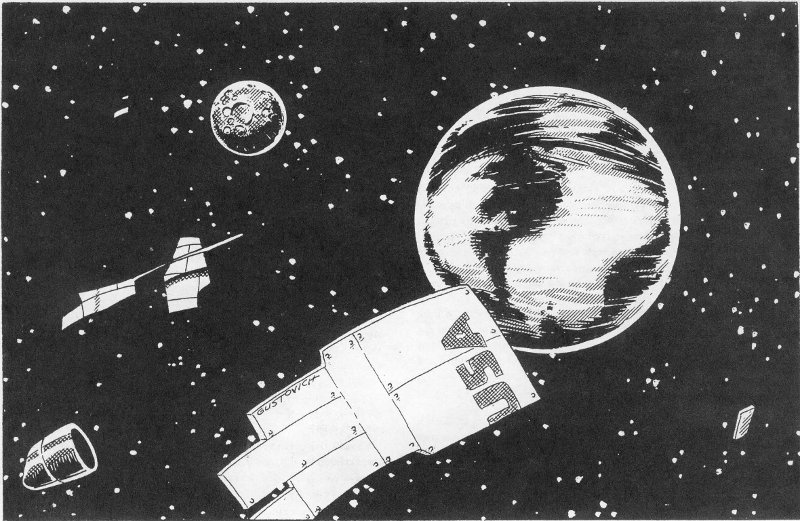
I'm just... struggling to find art to include here, okay?
Adapting to life in space
Zero gravity is an issue! It makes you weak, and the book gets into the science of it relatively well, except-
Mutants in Orbit posted:
Radiation and other things aside, a zero gravity environment as found in space and on the moon...
- whups. I think Wallis meant "low" gravity there. Not the last time the book will make that mistake, either. Anyway, you get muscle atrophy, fluid pooling, oxygen deprivation in the bloodstream, clotting, etc. It's noted that juicer and crazy technology can counteract the degeneration of zero gravity to some extent (if you don't mind having a chow hound or a crazy person aboard your ship, I guess...), and sometimes cybernetics are used to repair damage caused by long-term explosure. Also mutant animals - mainly dogs and chimps - are used in zero-g because fuck'em, they ain't got rights.
Anyway, if you only spend a few months or years in zero gravity, you can recover through physical therapy. However, the rules give you a 9% chance of dying per day for the first week, and your Physical Endurance does not help. That's a 48% chance of sudden death. They... may have wanted to read the science on this one a bit more, because nobody I can find of in the history of space flight has died from a few months in zero gravity.

Sigh. Anyway, humans can completely adapt to
 Moon juicers and moon crazies, as well most mega-damage folks don't have to worry about this. Cyborgs or folks supported by power armor, though, have improved 99.9% chance of dying in their first day of normal gravity!
Moon juicers and moon crazies, as well most mega-damage folks don't have to worry about this. Cyborgs or folks supported by power armor, though, have improved 99.9% chance of dying in their first day of normal gravity!
Rifts: MATH IS HARD.

Decompression sickness can occur, especially for non-natives used to the variations in orbital environs. People can be penalized or in severe cases put into a coma, and then have to make a standard death save. Also, people can be bummed out by being too lonely in space or never being lonely, one of the two.
Various sections about resources summed up
Anyway, space people are horrendous environmentalists in that they try and conserve and recycle everything . (Yes, pee and poop counts, I'm sure.) Oxygen is created through hydroponics, chemical systems that extract oxygen from water, and various means of recirculation. Other materials are often melted down and reused or re-crafted (like with clothing). In manufacturing, just about every byproduct is saved and used somewhere.
Water is the big deal, though, and mining Mars' ice caps and asteroids is the main source, which leads to occasional skirmishes over prime mining spots, or just ice piracy in general. Yes. Ice pirates.
 Also, it's not stated directly, but orbitals drink their own filtered pee pretty much all the time. Also, a lot of stations store water in walls to protect against heat and radiation, but that seems dependent on the romantic assumption nobody's going to poke holes in your walls...
Also, it's not stated directly, but orbitals drink their own filtered pee pretty much all the time. Also, a lot of stations store water in walls to protect against heat and radiation, but that seems dependent on the romantic assumption nobody's going to poke holes in your walls...
Oh, and IOU refers to "Ice-Oxygen Units", so that's what the currency is based on. A pint of frozen water is worth 1 IOU, though nickel coins are used to represent them with a "forgery-proof hologram". Look, if you can make them, they can be forged. Emergencies tend to see a rush on the ice reserves, tho.
Power isn't a big deal, thanks to large solar collections and nuclear reactors.
Mining is mainly done on chondrite asteroids, and metallic asteroids provide iron and silicates. There's the moon which also has minerals, and the asteroid belt and mars can be mined as well, but they're more distant. Thanks to a surplus of energy, extraction and refining is relatively easy to do.
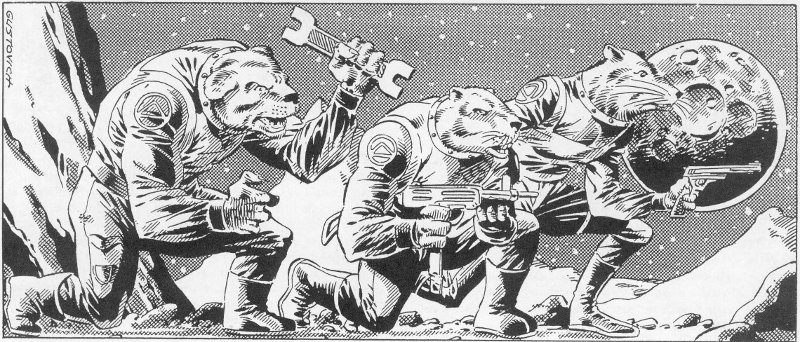
I think there's only one picture of a human in this book, period.
Crimes & Penalties
Fuck with resources and you get the horns. Most things having to do with ice, oxygen, or water is likely to get you spaced (the traditional form of execution) or put into hard labor camps on mars or the like.
Orbits
Most low earth orbit material is wrecked. Blame the rifts. Garbage and wreckage tends to congregate to the two main geosynchronous orbit points, creating "graveyards". Space stations are generally at the various Lagrange points or in geosynchronous orbit.
Whew! Honestly, this section is pretty factual and functional. The goofiness will start to really insert in the next section, where Siembieda is contributing more material.
Next: Stereotypes... in... spaaaace.
Yeah that reference never gets old for me, sorry!
Another reason to side with the more genetically pure, fellow isolationists on the moon.
Original SA post
Rifts® Space Part 4: "Another reason to side with the more genetically pure, fellow isolationists on the moon."
The Zone
This is a where orbital space stations are located! There are about 180,000 people out in space, including four space stations, the moonbase, and many small mining and observations outposts on the moon. Deimos, one of Mars' moons, is frequently mined for water. Most of the stations have 18,000 - 30,000 people in the Rifts version of the setting. Most stations get nearly 23 hours of daytime, so they fall into artificial day/night cycles. The other 70 minutes or so, known as "Shadow Fall", are when stations fall into Earth's shadow and the solar generators power down. None of the stations have means of propulsion - in a worst case scenario they could be tugged into a new location.
Overpopulation is a big issue... in theory. One of the problems with Rifts Space is Siembieda wanted the Rifts versions of the station to be more grandiose. So he multiplied the populations of the After the Bomb stations by three... and then multiplied the size of the stations by three. The problem is, we only have dimensions for the stations, which would expand the space available roughly twenty-seven times! What Kevin probably wanted to do is increase the volume of the stations, though that isn't clear. Otherwise, things get really roomy!
All of the stations also have their own security forces and small fleets with which to defend themselves and enforce their respective laws.
There are also freebooters and traders that serve as independent travelers and transporters in the zone, and get treated like crap, but most stick with it on account of the high potential profits.
Most of the stations speak English, though Laika station still speaks a lot of Russian, and Yuro speaks various European languages. The language barrier is often used as a fake excuse to blow people off in inter-station diplomacy.
Freedom Station
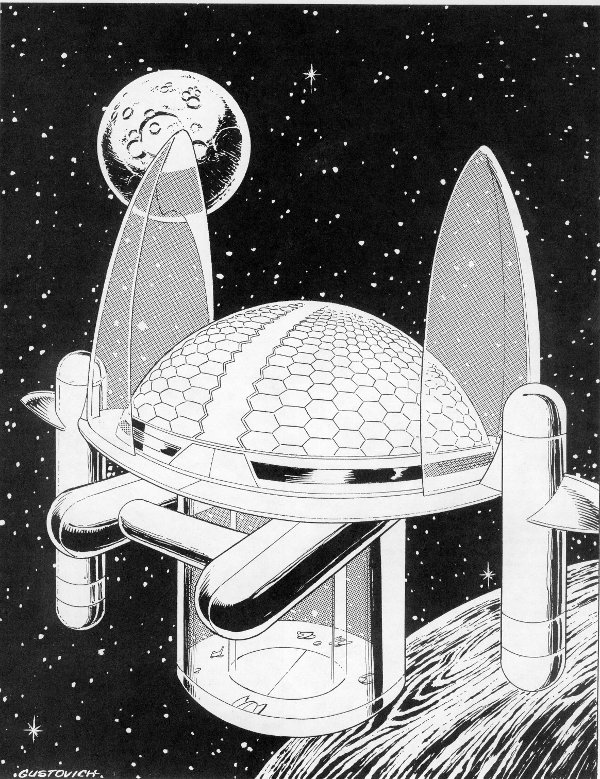
Apparently their station design largely borrows from Duck Dodgers.
This is the oldest of the stations, originally founded by the American and Canadian governments. Now, though, it's largely been taken over by the private sector, most notably the robotics firm known as the KLS Corporation. Freedom is the station most open to outsiders, and has become the premier trading hub and refuelling station in orbit. However, it doesn't have a proper police force, and has a rep as being wild and lawless, though the Committee (the local governing body) looks after major breaches along with the local station defense. A lot of the station is heavily computerized, and cybernetics are relatively common. This station has bioware technology largely cornered, and their computer systems also make them a center for communication.
It's sometimes called "Yankers", is located at L-5, has artificial gravity (through rotation). People have surnames based on the # of the module they live in, and lower numbers are more prestigious. The various modules are, well, modular, and can be moved around for repairs or the like. The station is run by a democratically-elected and fractious Committee that also doubles as the station's main court.
The KLS Corporation is the dominant economic force, controlling about a third of the economy and three-fourths of the station defenses. They used to be a major military contractor for the US of A, and are basically a pack of Eighties corporate sharks who hate people and love money, though not necessarily in that order. They're rivals for the Cyberworks corporation, who are honorable, nice military contractors . Because Cyberworks showed them up all the time KLS Corporation is super obsessed with finishing of that goody-two shoes Cyberworks once and for all! They're getting ready to make war on the Moon because that's where Cyberworks is.
KLS has two families - the Longven family and the Sims family - who work together all the time and are functionally identical so who gives a fuck that are two families? They "get along famously and think of themselves as one big family." The Committee is somehow completely unaware that KLS is trying to manipulate them into war.

Time for number porn! It has 42,000 people. 10,500 of those have superpowers. There are 4,250 Glitter Boys; if they're all manned, then 1 in 10 citizens is a Glitter Boy pilot. If you only count humans, that means 1 in 6 humans are Glitter Boy pilots. They produce an average of 50 Glitter Boys a month (well, 20-100, varying based on ???).
Anyway, KLS is leaking weapons to space pirates to basically privateer the moon. Also, they might get Laika or Outcasts to ally with them because ???.
USA! USA!
Laika Station
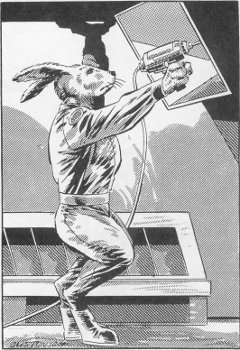
Communists breed like rabbits?
Named for the dead Russian space dog, this is Russia Station (with a backwards "R", no doubt). They're really nationalist and insular and generally hate everybody who isn't them. They only trade as a reluctant necessity. Everybody only gets a 7' x 7' x 7' cube to live in except for administrators and officers, who get two whole rooms to entertain visitors.
Laika's big deal is that they're the only ones who can still build new spaceships, as they're the only ones with major spaceship construction facilties. They also have decent refineries as well. Their command structure is military, with Commanders overseeing various departments, and the current military head is Comrade General Algonov. They also have a dilemma where they're running out of fissionable material, but don't have enough solar panels yet to keep up with their energy demands. Laika also keeps a secret network of observation satellites in Earth and lunar orbit. They also have some old Glitter Boys, but none of the newer models presented later.
They deal closely with Yuro Station for energy and electronics, since the see them as harmless. Naturally, in keeping with their Soviet-era stereotype, they are paranoid about the machinations of Freedom Station because they have too much freedom and let in all sorts of dangerous undesirables. They also tend to be allied with the CAN Republic (THE MOON) as they see them as victims of persecuition by Freedom Station. Siembieda takes this further than Wallis, making them into outright racists against mutants of various sorts.

Yuro Station
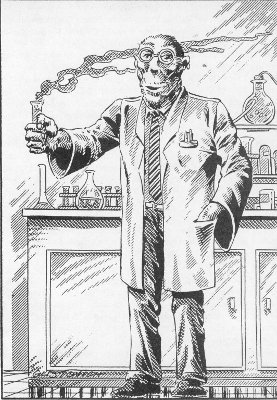
"Lab monkey" takes on a whole new meaning, apparently.
See, it has a Y instead of an E because the future . This station was created by the "European Community" - i.e. Britain, France, Italy, Spain, Germany, Sweden, Denmark and Norway. There's a lot of paranoia and bickering between the various national forces there, and sometimes bodies hit the floor as a result. They're supposed to be part of the same council, but there's so much disagreement it only meets in dire emergencies.
The French are largely in charge, as they have control of most of the Yuro ship fleet, and do most of the trading and diplomacy as a result. The massive solar sail gives the the station a major economic edge (but also a serious vulnerability), and they export a lot of power. They have also the best refinement facilities (using nanotech) and medical facilities. The Scandinavians are the primary experts in medical technology.
Yes, that means they have the technology to make juicers and crazies (though they do so only sparingly). They once experimented with juicer technology as a means to deal with atrophy from low or zero gravity, but the main result is just plain juicers with reduced reflexes but greater ability to survive for extended periods in zero gravity... and becomes immune to mental attacks! Why? No reason. There's also rules for mutant animal juicers, who get the same benefits but become more feral. Why? Because... um... anyway, they lose Intelligence and Affinity, and can't get above-average in either stat. Mutant animal crazies get supernatural sensitivity like dog boys and added psionic powers, but basically can't have even average Intelligence or Affinity, and are more vulnerable to psionics than your average crazy. Also, mutant animal crazies that last over a decade "frequently develop a taste for blood and 40% become cannibals". Wait, I don't think they understand what "cannibal" means - does a mutant mouse crazy feed exclusively on other mutant mice all of a sudden?... no, I don't think think that's what Kevin meant.
Bad numbers time! 22% of the Yuro human population (about 30,600) are juicers. Juicers last about six years since the start of their treatment. There's 6,732. This means to maintain that level of juicer treatment over two decades, they'd lose half their population , because Kevin Siembieda can't ever be bothered to do math . These horrible abuses of statistics come from Kevin's side of the book; James Wallis generally can actually handle numbers responsibly. Generally.
Each wing / faction has its own government - most are democratic, but the Brits have a monarch, King Phillip (fucking seriously?), and Sweden & Denmark are socialist republics. Surnames are based on your country of alliegance, so you'll have folks like Brian Britain or Francis France.
Britain and France handle most of the station defenses, but there are rumors that Italy is inventing an x-ray laser (yes, powered by a nuclear explosion). The French are also the ones to blame for the M.O.M. (crrraaaazy) technology. The Germans invented juicers, but also has old-fashioned Glitter Boys, special secret armaments, and power armors comparable to Titan power armor.
The station itself is called "King Angel" sometimes on account of is massive, wing-like solar sails. Of course, these are really vulnerable, which adds to the infighting and paranoia on the station. They have good relations with Laika, and heavily distrust moon colonists and freebooters. In fact, they're secretly preparing for a war against the moon colonists and a liberation of its resources. To this end, they might create suicide squads of freebooters and Outcasts boosted with juicer or crazy technology.
Outcast Station
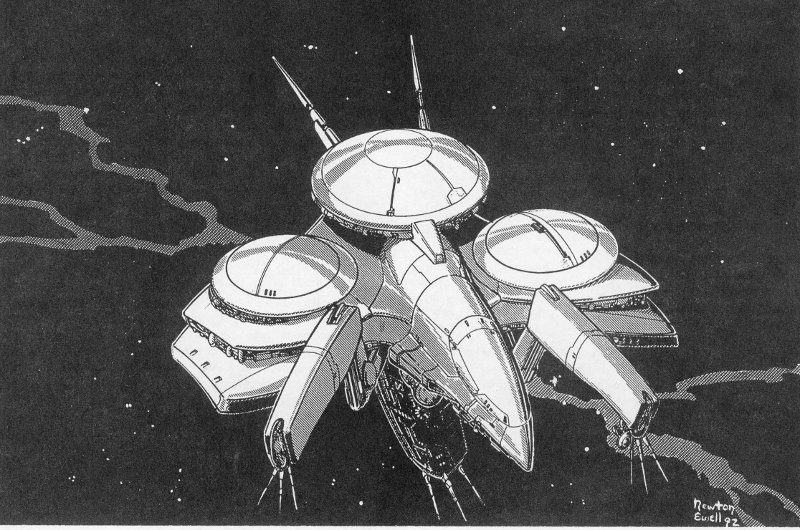
This is Outcast Station, maybe?
Mutants in Orbit posted:
The Outcast Station is the home of all the dregs, subhuman mutants, the disadvantaged, unconventional, retarded, and hideously mutated in the orbital community. Although most of the other stations and moon colony refuse to have anything to do with the Outcasts, they frequently send children, badly mutated by radiation, to the station, where they hope that they will be looked after by their own kind, subhuman mutants.
"Subhuman" and "retarded". No, not the most politic way to put things, Wallis. Anyway, this is a wild and wooly place where gangs rule and people get thrown out of airlocks pretty much all the time. And people send their babies here! Way to go, people. "He has an extra toe, time to throw him to the wolves ." Unlike other stations, people can carry guns, including ones that can shoot holes in the station because whythefucknot. They constantly need new supplies of oxygen and repair parts because they're a pack of fucking lunatics. Seriously, they're sometimes called the "Nihilist Metas" and exist in "near total anarchy".
They support a lot of scavengers and pirates, though, because they don't have great industry to otherwise support heir station. Sometimes they outright raid other stations, which usually results on a lot of outcasts dying. However, a lot of independents turn to the Outcasts because the Outcasts have zero standards.
A lot of the station has issues, like radioactive areas, decompression, and zero gravity. However, it has more superhumand and mad geniuses than others. In addition, the criminal organization known as the Network tends to use the Outcasts as tools. However, when they're attacked, they bust out like killer bees and just murder the fuck out of people.
They tend to have names "Zero" or "Ripper" or name themselves after pre-Apocalypse products so you get names like "Dave Teletext" or "Ian Twinkie" (these are actual examples). Gangs handle what organization there is, with the head gang being the Solar Rogues. The Solar Rogues are led by "Fire Brand", who can turn into fire and shoot fire. Not the best power to have aboard a space station, I suppose, but there you have it.
Most of the station is built up out of the Japan Station, a supply ship, part of an asteroid, etc. It's similar to a "Rifts 'Burb'" (ugh, Rifts slang . Basically they're a bunch of mutated, superpowered fuckups and it's not clear why the station didn't blow up decades ago. It's noted that player characters somehow arrive from Earth, this is a good place for them to settle in, since Earthen player characters are invariably going to be freakish.
Speaking of which, it's time for the Siembiedan bad number parade: of about the (roughly) 20,000 inhabitants, about 6,666 of them are deformed mad scientists. Fucking seriously. Half of those are insane. There's no dire outcome of this, but seriously. A third of the station A) loves science and B) hates mirrors. It's like Oolong Island only not on purpose.
Bonus Kevin Siembieda trope: the Outcasts hate the Moon people because the Moon people are still largely pure human extraction and pretty . Yes, another foul nest of uglies that hates them pretties, hates them so much with their smooth skin and perfect teeth and uncircumcised cocks... which makes no fucking sense, since the Moon colony has no gravity, so the Moon people would be all gaunt and creepy and shit. These folks have a 50% chance of instant death under at any location over 0.5 g under the rules. They're not healthy, and Kevin should know that. It's pretty clear in Wallis' material.
Oh, and somebody recently left some Martian mutant insects here to work as slave laborers. This is clearly a great plan and certainly life will not find a way and chaos theory is just a bunch of nonsense. (Yes, mutant bugs. We'll get to those in an update or two.)
must drive faster
Next: Aliens, asteroids, and THE MOON.
They are so powerful that they distort gravity, light and the fabric of time and space, drawing everything near them into their hungry dimensional maws.
Original SA post
Rifts® Space Part 5: "They are so powerful that they distort gravity, light and the fabric of time and space, drawing everything near them into their hungry dimensional maws."
The Graveyard
Sino-Japanese Station
This is the rest of the Japanese station that got blowed up that didn't become part of Outcast Station. All of it gravitated to the L-4 zone, where it mixed up with old satellites and debris, including old defense satellites and mines. There are rumors of ghosts, aliens, pirates, monsters, etc.
This being Rifts , there really are aliens and monsters here, of course, largely attracted to the "emotions and deaths of the Graveyard's victims". Sometimes desperate scavengers and pirates will come here. However, it turns out there's a ley line nexus (wait what how- ) here that occasionally opens up a rift. In response, Cyberworks and Yuro have fired killer satellites into the area that will just kill anything.
So, there are ley lines in space? How does that even work? We don't get to find out, mind, it's already time to move on.
Little Green Mutants?
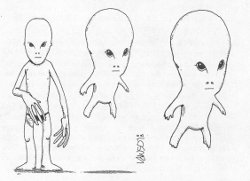
Not an actual alien, but a mutant human from another Palladium book.
Also, as an art direction thought, if they're going to reuse a piece of art, they should at least do it on different pages maybe, and not just have the same piece twice on the same page .
Yeah, aliens. There's is strange phenomena and odd lights in space that stay just out of weapon range, missing time and mysteriously rescued ships, or strange artifacts meant for three or seven fingers. Most people are really paranoid about aliens, and generally take a shoot-first-and-ask-questions-never attitude.
Basically, it's up to the GM whether or not there are real aliens. The book directs us to other Palladium games, like Beyond the Supernatural with its energy being UFOs. Or Robotech ! That's a crafty mile-long Zentraedi battleship, it is!
Independents
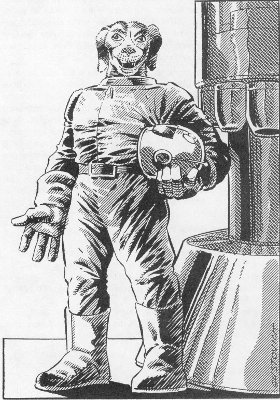
That helmet and that head do not go together.
There are about a hundred small satellites and spacecraft that serve as homes and small businesses. Most are in "the Zone", but some are in the asteroid belt. They are generally just spaaaace hiiicks, but about a third are wealthy private enterprises.
There's freebooters , who are independent ships and crew members who do charter, supply, trading, and chaffeur work, largely. Others work in recovery and rescue, and some resort to piracy. There's also "snowballing", where you pilot a big ice cluster from the asteroid belt to Earth orbit. Most freebooters center around Freedom or Outcast station, as well as an asteroid belt outpost called the Belt Way.
Next is the Network , an organized crime family. They mainly provide a black market, but also do protection rackets... that actually do provide protection. And also racketteering. They also try and corner organized crime, and are pretty good at doing so (since the orbital community isn't that big). Their head is "Baron Dioxin", who lives on the Inside Joke, a yacht stowed away in Earth orbit. About one in four freebooters pay protection to the Network.
Miners generally work the asteroid belt or Deimos (a Martian moon), generally mining iron or ice. They tend to be close-knit and help each other out quite a bit, as the margin of survival in the places they work are slim. However, there are conflicts over claims, and lethal claim jumping is not unknown (but deeply frowned upon amongst most miners). Loads are either dragged back by ship normally or slingshotted from Jupiter, or more rarely actual engines are attached to the load and the whole thing is piloted back. It should be noted that space speeds are relatively realistic, so you're looking at an eight month trip back and forth.
The Asteroid Belt is, as mentioned, home to a lot of mining. There's a lot of
 on asteroid compisition which I'll spare you. There are rumors of solid gold rocks and a great white asteroid that's a giant diamond called "Maybe Dick", but no real credence is put in those sorts of stories. In addition to miners, there are also belters, who maintain small homesteads based on ample supplies of ice and sophisticated hydroponics systems.
on asteroid compisition which I'll spare you. There are rumors of solid gold rocks and a great white asteroid that's a giant diamond called "Maybe Dick", but no real credence is put in those sorts of stories. In addition to miners, there are also belters, who maintain small homesteads based on ample supplies of ice and sophisticated hydroponics systems.
People don't go further out just because it's not practical in terms of fuel and time. There are rumors of old bases established further out, and there certainly are unclaimed riches, but survival is difficult enough in the asteroid belt to venture beyond.
The Belt Way Station is a small outpost that basically serves as the main rest stop for the asteroid community. It's owned and operated by the Wintels, "a family of tough wilderness space scouts". They offer meals, alcohol, gambling and games, basic supplies and treats. They also do subsistence mining here as well.
Comets aren't of much consequence, but can very, very rarely be a hazard for ships or stations.
The Containment of Earth
The colonies are afeared of Earth somethin' proper, and have agreed on one thing and one thing only: blow anything that comes into orbit to kingdom come. Well, except Outcast Station, which doesn't give a good goddamn. Cyberworks in particular contributes "dozens of ships, satellites, and robots on patrol".
Yep. Dozens. For the entire Earth orbit. "... nothing has been able to slip through the containment network in centuries." This assertion is on the level of "and then I emptied Lake Superior with a spoon." It's such a misunderstanding of scale that it boggles the mind. And it's all Siembieda. Wallis actually seems to have some grasp of what he's writing about. Kevin is just...

The Moon
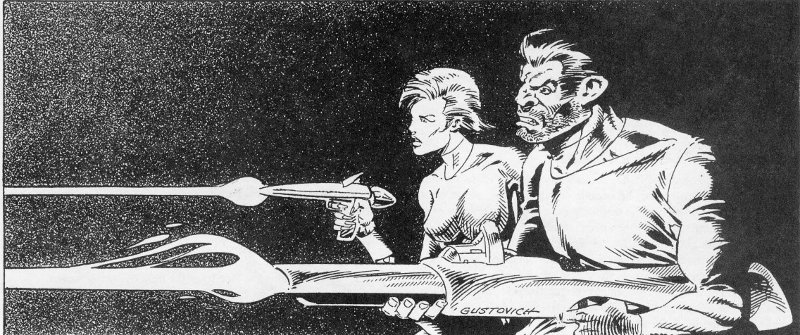
Humans?! Well, the guy is a little debatable...
We get a lot of Moon Facts, and then some description of the colony's power source - they use solar satellites to beam down power, but also use nuclear and hydrogen gas power systems as well. Most of the colony is underground, using hydroponics, and there's rich mineral resources to be found. They an even convert regolith (they use the term "sand") into oxygen, though they need to import water.
Moon Colony: Mare Imbrium
The Near Side of the Moon
This Colony, unlike the stations, is largely run by a single company: the Cyberworks Aerospace Network (CAN), and was originally built as a self-sufficient manufacturing facility. After the apocalypse, they recovered quickly and renamed themselves the CAN Republic as an independent nation. Ultimately, they've become one of the most technologically advanced forces in space or even compared to Earth (though later supplements will make that assertion into a lie, particularly when it comes to forces like actual aliens with FTL technology ). Their pressurized domes are storage and docking bays; most of the colony is entirely underground, along with mining. However, there's a rift between them and the other colonies because the Moon people feel that they can never go home because they're all atrophied with
They allow some outside mining, but ban all colonization of the moon, and are willing to fight for it. The moonfolk give no shits about any of the colonies save for their ability to import water and basically make no friends by saying as much. They're populous and highly militarized, and have an extremely well-defended colony.
There's rules for being a zero-gravity adaptee where you get physical penalities and no benefits to offset them. Whee! Some have resorted to cybernetics to offset this, but moon colonists don't touch Juicer or Crazy technology. They are only mildly touched by radiation and have a distinct minority of psychic and superpowered residents.
A democracy, their head is President Evarcha, though the Lane family has a great deal of authority. Who are the Lanes? Who cares! Much of the day-to-day management is handled by A.R.C.H.I.E. Seven. A.R.C.H.I.E. Seven is a descendant of A.R.C.H.I.E. Four, their original orbital AI. And yes, that makes it another in the same series as A.R.C.H.I.E. Three, the psychotic AI from Rifts Sourcebook and Rifts Sourcebook Two: The Mechanoids , but the book notes that Seven is a pure logic AI and is not sentient (and can be overridden by the President and his closest staff). Surprisingly, there's not even the slightest hint it might go berserk and start killing all the humans. Outwardly, the CAN Republic is largely allied with Laika, and have only tense relations with anyone else.
Virtual Reality Robot Defense System (VRRDS)
Also known as "Verds", this is a special remote-control technology unique to THE MOON. With a VR suit and helmet, this is basically a interface where the user controls a robot perfectly with their very mind, though there's input delays if the signal becomes distant (there are no rules for this, though). The robot is preprogrammed to keep fighting or retreat once the signal is lost, though they're crummy robot fighters on their own. They also make power armor that looks just like the robots in order to confuse their foes. I'm not sure how this confuses their foes, but is supposed to be quite cunning.
However, some people get addicted to Verds, and become "adventure junkies" as they try and replicate their feats from VR or seek out more Verds time. Apparently 15% of operators become adventure junkies, which seems like an alarmingly high number from a military standpoint. 4% become "Verds Schizoids" who lose connection with reality and go into dangerous flashbacks and hear voices telling them to kill and stuff, in basically total defiance of psychological cause and effect. Of course, being a Verds Junkie is actually a stat advantage as you get bonuses to just about everything. The Verds Schizoid gets the same bonuses, but also has a 50% chance to flip out and kill everything. The lesson is: a little insanity helps a lot.
Fun with numbers: there are about 100,000 citizens, and 18,448 robots requiring a total crew compliment of 22,944 pilots. That makes one in five people robot pilots. In addition, assuming half their pilots are VRRDS units, that means about 1,722 Verds Junkies exist and about 456 Verds Schizoids are around.
They may want to reconsider Verds technology given that it's driven roughly 1 in 200 people criminally and homicidally insane .

War for the Moon
Things seem to be headed towards Moon War I, but the Moon could be convinced to allow some ongoing mining outposts if diplomacy wins out, though they never give up technology or ultimate control of the moon. If war breaks out, the CAN Republic has a major weakness in that they get their water from Deimos, which is easily disrupted, but most of the workers there are just civilians.
Oh, and we get to find out a clear answer to the who the bad guys are (the KLS Corporation, Yuro Station, and Outcast Station) and who the good guys are (Laika Station and Freedom Station) by their "willingness to drop atrocities". The Yuros and Outcasts will even make literal deals with demons. The KLS Corporation, though, being evil but not eeeevil, likely would turn on anybody making deals with monsters.
Ley Lines on the Moon
It turns out there are ley lines on all planets, which is "why planetary alignments increase the power of ley lines and nexus centers". Fair enough. Also there are ley lines in space? In space. "Black holes are ley line nexuses on a cosmic scale."
Ooookay. Fuck science, I guess!

Anyway the Earth lighting up triggered the ley lines of other planets, too. There are about twenty ley lines on the moon, creating nine ley line nexuses, and two super ley line nexuses. The moon people have satellites watching the big two, along with killsats designed to kill anything that steps out of them. In addition, they have a scientific and military outpost near one to study and contain it.
Next: Nothing but bug-eyed Martians.
Kill or be killed and they are killing machines - super predators.
Original SA post
Got so much good chatter, I'm "rewarding" you with a second post for the day.

Rifts® Space Part 6: "Kill or be killed and they are killing machines - super predators."
Mars Base
We get a bunch of Mars facts - dust storms, light gravity, freezing nights, etc. It's main appeal for visitors is the ice trapped in the caps.
There was a base here, and the only serious attempt at terraforming in the setting. Satellites reflected heat down on the surface, which was irrigated and seeded with algae. Particularly after the Rifts, it began to prosper. The ley lines, apparently connected to the old canals of Mars nonsense, formed a Bermuda Triangle-like zone around the Mars colony and made it a warm, Earthish jungle because *MAGIC*. There have been other pockets around ley line nexuses that form liveable pockets, but most of the planet is still a wasteland.
Oh, and on the Mars base, a crazy scientist called Dr. Matthew Walters decided bugs were better than humans (because um science? I dunno) genetically changed them to grow big, breathe both oxygen and carbon dioxide, and picked species which could burrow underground to avoid the Martian winter. And then he released them! Everybody else was like oh shit, giant bugs,
in our beds
. Dr. Walters pretty soon was up against the wall.
Then Dr. Walter is like "Okay, I fucked up, but I got a plan. Also, not crazy anymore. So, we take the Bluebottle Bristle Fly, make it big, and it'll kill all the other bugs, and then die a few weeks later. Done in one, sons!" So they, in a fit of idiocy, believed him, and then Dr. Walters was like "Oh maybe I forgot to mention their preferred food is
human blood
." Suffice to say, a lot of colonists got exsanguinated. The Doctor busted loose then and controlled a bunch of bugs with chemical pheremones. But it didn't work out and the bugs fucking killed him anyway.
The humans held out for generations, but the bugs eventually ate them all, and the last humans died around two decades ago. Now Mars is populated by "giant insect cannibals" (yes, they eat humans, but they do eat each other as well). The bugs live on, but their growth is limited by the scarcity of food (and seriously, where the hell does a 300-pound bee find pollen?). Other colonies know the place is overrun and avoid it, but left the terraforming equipment as an experiment (in letting bugs overrun mars, I guess). Sometimes daring freebooters will try and scavenge things from the base, but mostly just die buggy deaths.
Mars has the moons of Phobos and Deimos, but only Deimos is visited regularly for ice mining.
Mutant Insects
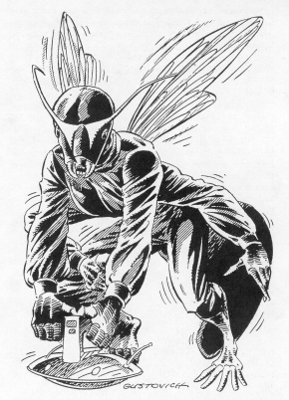
I don't even know - what the fuck?
We get a bunch of bug facts! There's a fair amount of detail, but I'll skip them, there's nothing egrigiously wrong here, you can check wikipedia. Here's some of the odder facts about mutant bugs!
-
Mutant bugs are M.D.C. Why? Not because of magic. Or technology. So basically no reason. They also get M.D.C. attacks, of course, despite not having supernatural or robotic strength.
-
They can only make animal-like cries (including ultrasonic), but can learn spoken human languages. They can never learn to read, however.
-
They reach maturity in 30-120 days and live 20-50 years (?!).
-
Mutant bugs have no feelings and basically are "super predators" that will kill and eat anything.
-
Mutant ants can use military tactics like a real army. Or, at least, armies as Kevin Siembieda understands them, which means discrete units with focused purposes.
-
Despite being mute kiling machines that see all mammals as "food or enemies, or both", you can play one as a player character.

-
Though they're dumb and operate mostly on instinct, they aren't suicidal and can sensibly avoid harm and retreat, unless defending a hive or queen, in which case they swarm attack.
-
They can learn now to open door and use basic devices (they can shoot a gun, but not reload it).
-
They also have various warning, attraction, death scents, and other pheremone shenanigans.
Common Mutant Ants
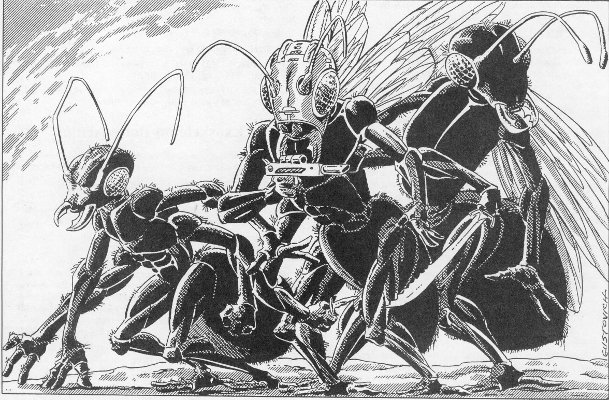
No word on where the bug-sized helmet comes from.
These are some kinda "smart" bugs. They have an organized society, use weapons, and at times war between colonies. They're one of the most dangerous varieties, on account of being numerous and cunning. They get a ton of powers from After the Bomb I'm not going to go over in detail. Did you know ants can apparently identify temperature at 80% within 1d6 degrees? Females can squirt fuck-me juice at males and males are like durrr must fuuuck. They can run at 60 MPH - zoom zoom goes the swarm. Some get wings, some don't. They also, on account of their compound eyes, all get automatic dodge / parry along with a high dodge bonus, which would make them intensely annoying to fight in swarms (not that it makes much sense anyway, ever seen an ant sidestep?). They get solid M.D.C. (130-240) and get special rules to pound on people with boulders for extra M.D.C. damage. They can also be used to make above-average M.D.C. armor.
Oh, and they can fire guns and reload them. And they're as strong as many adult dragons!

Bee
More hive bugs. These ones feed off of nectar - somehow - despite being 4 1/2 feet tall. How they extract it is left as a exercise for the reader, I suppose. Likewise, they have a ridiculous number of powers, like automatic dodges. Their unique abilities include wax glands to excrete wax, leg sacs to carry pollen, and a dreaded stinger that does... 1d6+2 M.D. No poison, for some reason. Nor does stinging harm them.

They can learn to open doors, push buttons, and pull triggers, but do much in the way of complex tasks. Oh, and they get "Sing (buzz and vibrations" as a skill. But no bee dance! Also they can swim, you know. Like bees do. You can also make armor out of them. Finally, there are also rules for wasps, which are just like bees, only faster (150 MPH instead of 60 MPH).
Beetles
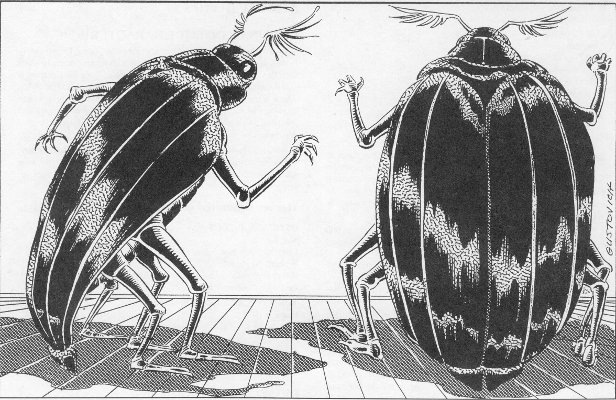
heeeeyyyy hooooo
We get told there are many types of beetles - over 300,000 species! Then we get one statblock for them all.

They're super-tough (about as tough as a dragon hatchling or gargoyle), and some get the ability to squirt toxins "from the spraying oriface" that blind and burn on a failed save vs. poison. They're stronger than even most adult dragons (even though they're only 8 to 10 feet tall). Like bees, they can operate simple tools and machines, and apparently are "very aggressive". You can also make their shells into body armor that has poor mobility, but provides a relatively impressive 100 M.D.C.
Cockroaches
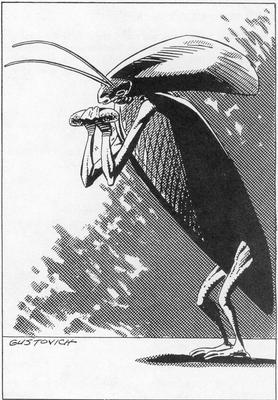
This one's a cannibal for bread!
Unlike their reputation as survivors, cockroaches get the least M.D.C. we've seen out of the critters so far. They get the chemical spray some beetles do, can use simple tools and devices, and... are cowards. Their butts can be used to make stink bombs. They're "garbage cans with legs". Next bug, please.
Earwig
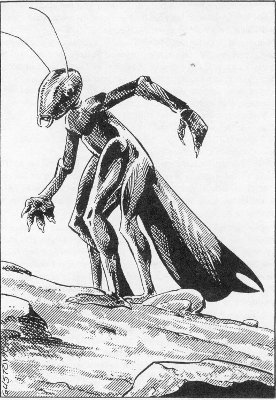
Has had enough of your fascist "chairs".
They have butt pincers can can pinch you with their butts. It does 2d4+2 and automatically pins whatever they hit. Human? Pinned! Dragon? Pinned! Battleship? Motherfucking pinned ! Also once they pinned you you're helpless and they can bite you forever unless somebody else offs them. They also get the stench squirt and automatic dodge too , if you weren't sick of either already. Also they can use tools etc. Boring!
Fly: Common
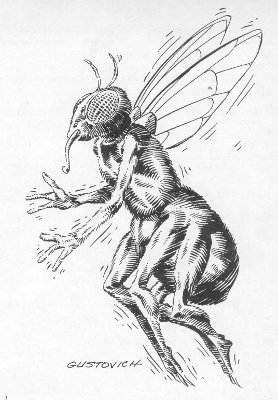
Baxter Stockman is statted in a different Palladium book, actually.
Yep. Flies.
They go 300 MPH and uh, they get a stabbing mouth to drink blood or nectar. Given the absence of 6' flowers, presumably this makes them Martian vampires. (They even get iridescent bodies.) They're as tough as bees, and really have just similar statblocks. You can make armor out of them, they can use tools, auto dodge, etc. Pretty much by the numbers here. One point of confusion is that it gives details for bluebottle flies as a variant here, and then gives an entirely different statblock following them.
Bluebottle Bristle Fly
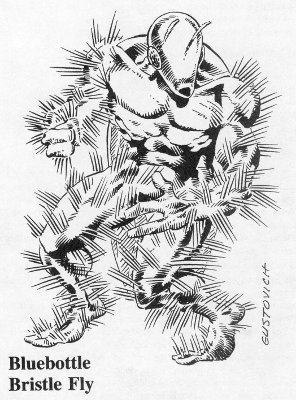
"Fuck, I need a shave."
This is " For Rifts Only " but at the same time they're part of the same backstory as Mutants In Orbit . What's more, they're presented as hyperaggressive super killers, when in reality the fly in question is... a relatively normal scavenger fly. For some reason, these are presented as berserker killamajigs. The irony, though, is that it's hardly the toughest bug - it's about average - and actually does less damage than ants due to its lower strength. It's a "cunning and ferocious hunter" but is less dangerous by far because it's so savage. Even with special bonus damage from flying strikes (wings not pictured for some reason), they're not really capable of doing serious damage.
Praying Mantis
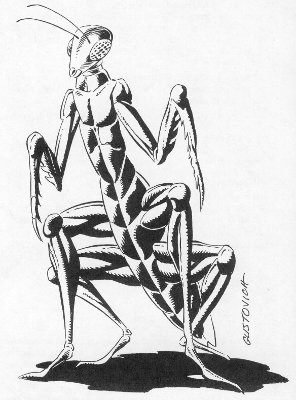
Draw a regular bug, call it a mutant: the Gustovich method.
This goes on and on about how mantises eat each other up. Only the strongest survive; mantis derby! Stat-wise, they have a 75% pin attack that does 1d6 M.D. a round (and it can chomp down at the same time). They're one of the toughest monsters - about as tough as beetles - but barely grasp doors. You can make armor out of them like beetles. Not much else to say.
And that's all about bugs on Mars.
Next: Back in concert - The Glitter Boys!
Another wrinkle about the schizoid in particular, is that the VRRDS Steel Dragon operator will begin to think of himself as not being human, but a dragon.
Original SA post
Rifts® Space Part 7: "Another wrinkle about the schizoid in particular, is that the VRRDS Steel Dragon operator will begin to think of himself as not being human, but a dragon."
Robot Vehicles & Power Armor
The "standard features" are just like normal power armor in Rifts (see my corebook review), only that ones in space generally have linkups to station or satellite sensors.
KLS Glitter Boys
And now, we find ourselves to the most controversial part of the book. Glitter Boys, undoubtedly the most powerful combat machine from the corebook, gets upgraded version. This often gets pointed to as part of the "power creep" of Rifts, but I think that's a mistaken assertion. First off, the Glitter Boy in the original book is already broken - adding 33% extra damage is devastating, but the problem is with the original design, not the versions in Mutants in Orbit . Secondly, the orbital setting is about as divorced from the core setting as they can make it, so the new Glitter Boys can't appear in most games. Thirdly, the newest model of Glitter Boy in this book, as we'll see, is actually notably worse than previous models.
No, the dumb part about Glitter Boys... in... spaaaaace is that they're just tactical embarassments. Their attack range is rated in a mile or two miles, and they move in space via thruster at 150-300 MPH. The problem comes up in that missiles in Rifts have a range of a few miles to hundreds of miles. The solution: load space fighters with missiles, fire at Glitter Boys until all the Glitter Boys are dead.
Of course, in theory laser weapons should also outrange most of the Glitter Boys, but for some reason this book ranges lasers in thousands in feet (around 1 or 2 miles), when they should have a potentially much, much higher range. In most Rifts books, I'm willing to handwave the complete unrealism of most rayguns - that's fine. The problem is that Mutants in Orbit bases itself more in realistic weapon systems like chemically-based lasers we have real data for, and then gives them extremely limited ranges... in space.

In any case, on to the glam mecha.
Glitter Boy - Mark III

Dozens of Glitter Boy pictures, only one picture of a GB pilot so far: Rifts!
This is supposed to be the same Glitter Boy from the corebook, but retrofitted for flight in space (up to 150 MPH) and boosted jumps in gravity. However, it gives up about 25% of its M.D.C. for this, so its armor is significantly lessened.
Mutants in Orbit posted:
The jets enable the GB to maintain its position when floating in zero gravity, while the pylons, acting with the jets, hold the armor steady on a surface and can even attach themselves to spaceships (inflict one M.D. and rarely punch all the way through the hull).
Yes, they still have the boom gun, despite the distinct lack of a boom while in space. And the laser drill pylons somehow don't seriously damage spaceship hulls... despite going 4.5 feet deep.

Alternately, instead of the boom gun, they can be retrofitted with a "VL-07 Variable Frequency Laser Cannon" that does less damage, but overcomes the laser resistance Glitter Boys have, meaning it's at least marginally more effective against other Glitter Boys. Mind, since the KLS Corporation has almost all the Glitter Boys , having them develop a weapon to mostly fight... themselves... is of questionable efficacy.
Old-Style Glitter Boy - Mark IV
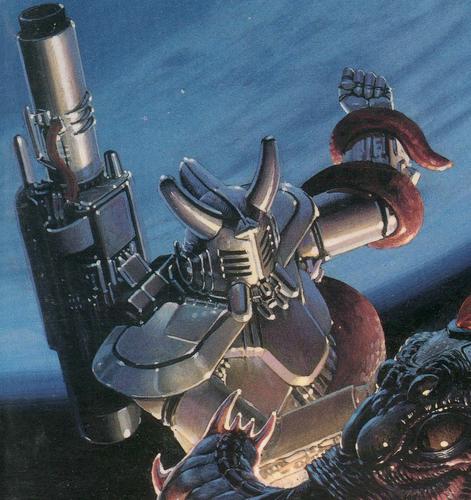
Horns.
This is the guy on the cover, and is probably the best Glitter Boy unit in the game at this point. It's tougher than any other at 800 M.D.C., and replaces the Boom Gun with a "PB-20 Rapid Acceleration Particle Beam Cannon" that does 4d6 x 10 M.D., instead of the Boom Gun's 3d6 x 10 M.D. The big drawback is that it has about a tenth of the Boom Gun's normal ammo capacity, so it can conceivably run out of ammo in a single combat, though it recharges one shot per minute.
Oh, and when it runs out of ammo, it gets a laser backup weapon that does... 4d6 M.D. You can't see me twirling my finger right now, and there's no emoticon, but let's just say it's pretty unimpressive. "Hey, if you lose your sword, you can use this toothpick as a backup weapon!"
New Style Glitter Boy - Mark V
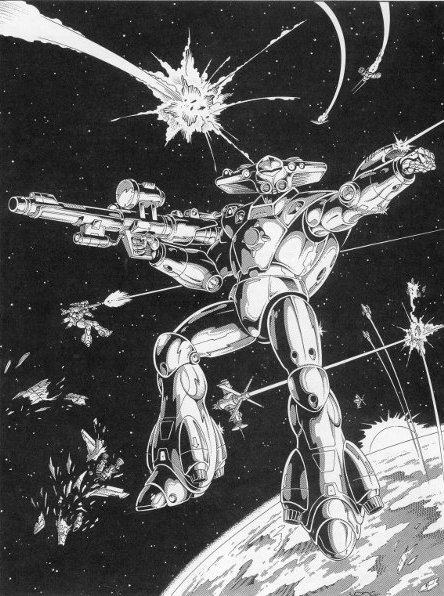
Headwings.
This is supposed to be the first Glitter Boy designed largely for zero gravity combat. It can rocket around at 300 MPH. A blistering speed, until I remember that a relative piloted a Curtiss C-46 Commando during World War II, a sluggish transport plane that went around the same speed... not real impressive in space, in any case.
It has 700 M.D.C., so it has about 10% less armor than the basic model. Where it falls down is the armaments - there's a "PBM-15 Rapid Acceleration Particle Beam Mini-Cannon" with a measly 1d6 x 10 damage - 33% of that of a Boom Gun - and only 15 shots. The text makes a big deal of their secondary armaments - a 6d6 arm laser and a 3d6 head laser. Unfortunately, dual-wielding toothpicks does not make them more alarming as weapons. Thankfully, they can be retrofitted with weapons from the Mark III.
And that's the big power creep controversy! Only the Mark IV stands out as more powerful than the basic model and might be accused of such, but it has real issues in long-term fights of over a minute or so.
Cyberworks
Robots of the CAN Republic
verrrrrrds for nerrrrrds
All of the CAN robots - except for the hard suit - come in both a piloted and VRRDS version.
CAN Hard Suit
Power Armor
This is a suit more for mining and space work than combat. It has only light M.D.C. for power armor, improves one's physical attributes, and can fly at very modest speeds in space. No art for it.
VRRDS Samurai
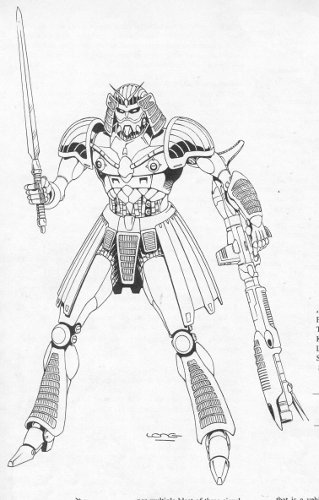
"It's really more like power armor."
It looks like a samurai because "they have VRRDS operator a psychological edge in that he or she would effectively become/control a recognizable heroic figure, famous for their combat skill, valor, and discipline." In other words, the designers were deeply weeaboo.
In any case, it's modestly tough, and can fly around at 150 MPH in space. It has a laser rifle that does modest damage. It's variable frequency lets it to full damage to Glitter Boys once it adapts, but most likely the Glitter Boy will have blown the samurai to hell at that point. It also has a vibro-sword that does modest damage as well. They also have shitty laser eyes and also have detailed hand-to-hand damage lists if they want to do shitty damage in hand-to-hand.
What I'm saying is I'm glad they have VR technology because these things are likely to get the hell blown out of them by Glitter Boys that are decades-old designs. For being so technologically advanced, Cyberworks is still struggling to make a decent giant robot, about a third as powerful as a Glitter Boy at about eight times the weight. Not much war machine per pound.
VRRDS Mikado
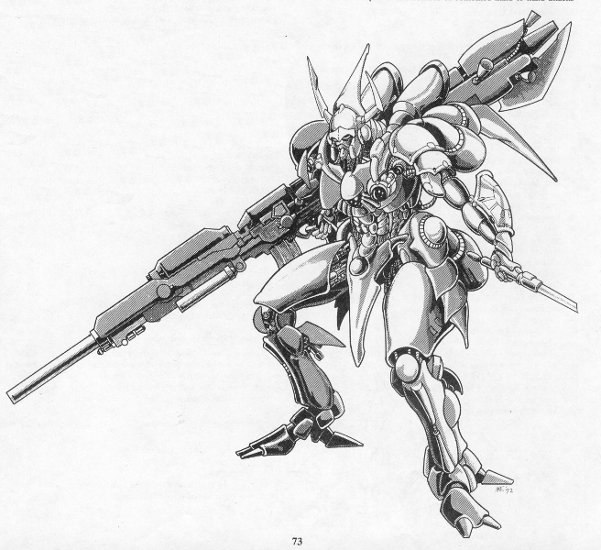
Assaulting both your space station and your cultural sensitivity.
Also known as the "Little Emperor", even though Mikado = Emperor is a western misnomer. (But then, this is a book that had a "Sino-Japanese" space station...) This is the heavy assault version of the Samurai, and actually gets a rail gun competitive with the Boom Gun. It's still weaker than the Glitter Boys, but only modestly so, and can rocket at a blistering 500 MPH in space and actually fly in an atmosphere. It also has the shitty sword and shitty eye lasers as the Samurai.
Usually I don't even acknowledge the hit locations - for the most part they're boring and pointless, but the Mikado in particular has a "Protective Armored Skirt" listed as a location that can take 150 M.D.C. Now, in the illustration, I don't see a skirt at all. I see a crotch protector. So it's a 150 M.D.C. crotchguard, apparently. And what happens if you blow it up? Nothing! Nothing at all. Why is it listed? I got nothin'.

The Steel Dragon
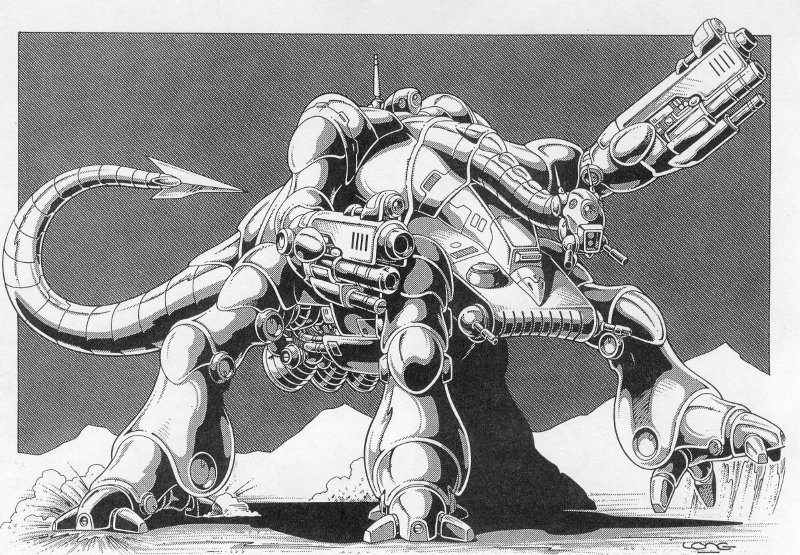
"It's really more like a dracotaur."
This is a big, four-legged monster-styled tank-thing. Its big advantage that uses one pilot and two gunners, getting the combined attacks of both gunners. For some reason it lists each gunner as having 6 attacks (and operates on that assumption) even though that could vary based on their stats and level.
Despite being a 32 ton war machine, it's only about 33% tougher than a glitter boy. It has laser arms, mini-missles, head lasers (all heads must have lasers, tiny laser turrets, and a blade tail. It does middling to solid damage, depending. It can barely move in space at 40 MPH.
Here's an issue: this thing costs 100 million IOU. A Mark IV Glitter Boy costs 25 million IOU. With two Mark IVs (50 million IOUs) against one Steel Dragon (100 million IOUs), which do you think would win? Let's put it this way: my 50 million is firmly on the Glitter Boys.
Laika Station
L-7 Explorer
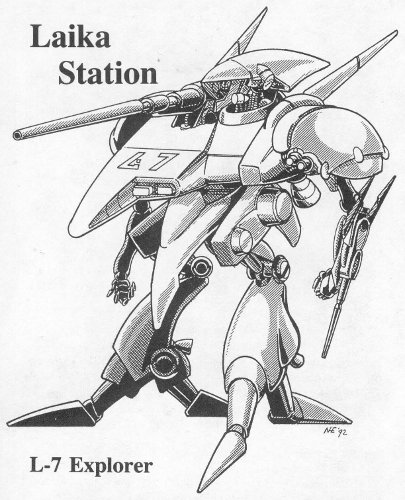
Tiny t-rex arms can never hug.
This is a dinky 22' exploration mech. It's actually pretty tough and can zoom around, and has a 1d6 x 10 Variable frequency laser, which is fucking stupid - why does this thing need an anti-Glitter Boy weapon? It'll take 8 or so shots for it to "align" to the Glitter Boy's armor, and then another 14 shots to actually pierce it. The Glitter Boy needs... 3-4 shots to obliterate the L-7 Explorer. What where you thinking, cosmonauts?
It also gets a laser and some mini-missiles, and it's the last of the robots in the book.
Next: How not to design rules to design spaceship designs.
You think it's a really stupid idea? These things exist!
Original SA post
Rifts® Space Part 8: "You think it's a really stupid idea? These things exist!"
Spaceships
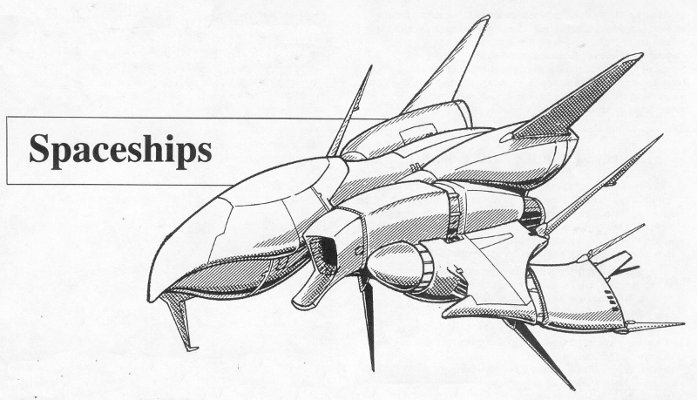
It's time for Newton Ewell's bizarro ship parade!
This is where we diverge from the usual Rifts robot parade - instead of getting a laundry list of spaceships, we instead get a spaceship creation system. This is a adaptation of the vehicle design rules from a Teenage Mutant Ninja Turtles supplement, Road Hogs . I cannot emphasize how terrible the vehicular combat rules from Road Hogs were, and it's a small mercy that they were never brought over to Rifts .
For spaceship types, we have:
-
Shuttles:
Based off the old space shuttles (i.e. the ones that just got retired a few years back), but newer ones are adapted for Moon or Mars landings.
-
Solar Yachts:
These are small, expensive crafts that have immense solar sails that propel them around.
-
Military:
This covers everything from transports and battleships to assault craft and bombers.
-
Cargo Transports:
yeah yeah yeah space truckin'
-
Self-Sustaining Ships:
Also known as "S-S ships" by people with no sense of history, which serve as flying space stations.
Designing Ships
And now we get to the actual design system. Now, a note: all of the ship designs refer to T.M.F. from Road Hogs , which won an award I just made up, the 1986 "Arbie" award for Most Tortured Acronym In A Gaming SYstem . That's Transient Manuevering Factor, by the way, and it's a balancing factor for certain ship sizes or drive types. But since it doesn't exist in Rifts , any ship can dart about equally well.

The Hull
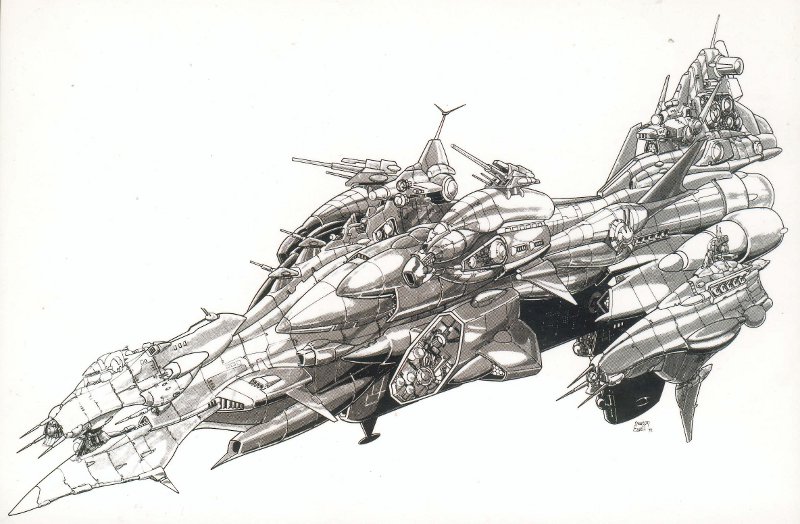
Meanwhile, this is what a ship might look like in a different setting!
Mutants in Orbit posted:
All hulls complete with walls, radiation shielding, piloting computers, power plants or solar panels, docking gear, airlocks, automatic pressure doors, acceleration couches, rader, basic repair systems, distress beacons, two-way radio with a range of 2000 miles (3200 km - double in space), reserve batteries, furry dice, go-faster stripes and everything else that a ship will need except for a drive unit, fuel, armor, weapons, recycling plant and a crew.
Too bad we don't even get basic stats in addition to all that! The main issue we have is that they have no standardized price, weight, T.M.F., available space for the hulls for the various spaceship types.
 The book gives us vague ranges, but nothing definitive. What's more, all hulls have only 90 M.D.C. without armor, so it's possible to have a 2000 ton cargo ship with 90 M.D.C. because you forgot to armor it up. Ooops.
The book gives us vague ranges, but nothing definitive. What's more, all hulls have only 90 M.D.C. without armor, so it's possible to have a 2000 ton cargo ship with 90 M.D.C. because you forgot to armor it up. Ooops.
Drive Type
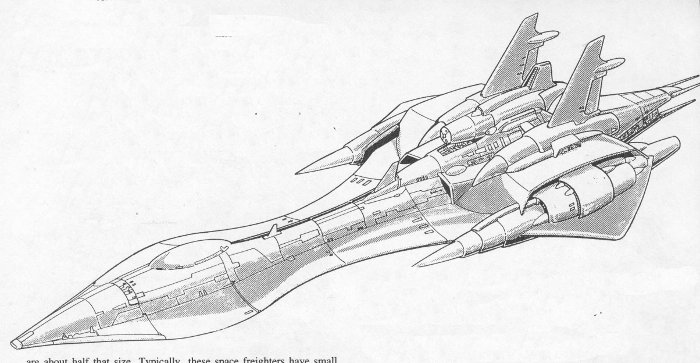
Xavier called; he wants his plane back.
This section also brings in another nonsequitur from Road Hogs : Speed Class, aka the top speed of a vehicle. For Rifts , that top speed is all it matters for, and the book does give a summary of Speed Classes 28-34, which covers the speed ranges in this book - MACH 1 to MACH 5. Which is curious, because achieving low Earth orbit requires MACH 25 . I understand most of these will be purely orbital vehicles, but it doesn't seem in like with how acceleration and speed actually work in orbit, as well as in zero gravity.
Also, fuel costs are standard, meaning it costs as much to rocket around a light 1-ton fighter as a 2000-ton freighter.
In any case, there are five drive types provided:
-
Chemical Drive:
This burns a mixture of hydrogen and oxygen to rocket a ship around. It's responsive but kind of sluggish.
-
Ion Drive:
This converts hydrogen into an ion stream to propel a craft, and is pretty swift. It's more expensive than a chemical drive, but cheaper to fuel.
-
Plasma Drive:
This runs off a nuclear reaction powered by deuterium and helium-3. It's still largely an experimental technology, but has good speed and fantastic range, though the fuel itself is very expensive.
-
Traction Drive:
This, uh, creates a "very powerful and specialized psuedo-magnetic field which attaches itself to the fabric of the space=time continuum and pulls the spacecraft along after it." It can run off of solar or nuclear energy, giving it an immense range. Even though it's given a low Speed Class for a spaceship (MACH 1 to 2), it says "Theoretically this drive system could reach the speed of light, but it would take a year of constant acceleration." Manueverability is horrible, but
Rifts
doesn't care.
-
Solar Drive:
An underpants gnomes sort of drive; it runs off of solar power, and then provides thrust through... um... it doesn't say.
 Expensive and kind of average, though long range as long as it's catching rays.
Expensive and kind of average, though long range as long as it's catching rays.
Spacecraft Armor
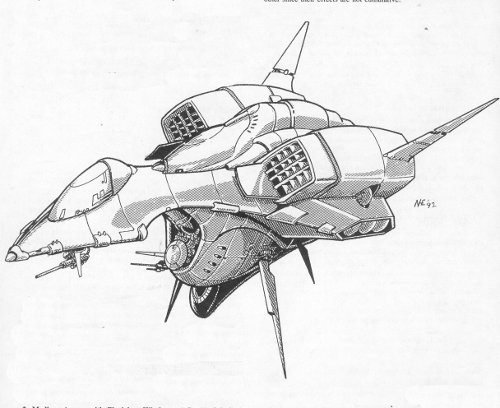
This one's a little lopsided.
The cost, weight, and effectiveness of armor is basically determined by a vehicle's tonnage, and what sort you select (light, medium, or heavy). Heavier armor costs more, but provides more M.D.C. A shuttle might have 300-2000 M.D.C or so, and a freighter would be around 1500-15,000 M.D.C., for example.
There's also Radar-Invisible Armor that gives you a 89% chance to avoid radar, and Reflective Armor, which halves laser damage like a Glitter Boy does.
Weapon Systems

This is the terrible thing that happens when you ask Ewell to draw a missile.
Weapons! The number of weapons you can mount is limited by your hull type. It's a damn shame they never strictly define hull types, and the limitations are confusing as it is. A "small shuttle" can only mount two weapon systems. Looking at the shuttle weights, the lightest weight I see for a shuttle is 60 tons. The thing is, a jet fighter (around 20 tons) can mount more weapons than that... hell, as listed, a small shuttle can't even mount any missiles (it's too small, apparently?), when a fully loaded fighter can carry roughly a dozen.
Most of the weapons are generic; there are light and heavy weapons of each type, and you always want the heavy if you can afford it, it's mostly just price increase for double damage. There's lasers, ion, particle beam, and rail weapons. The large rail gun is probably your best bet, at 45,000 IOU - a fraction the cost of other large weapons, but the same or better range and damage. You can also mount a mini-missle launcher or, if your ship is very large, regular missile launchers.
There are a variety of defensive countermeasures also listed, like anti-missile missiles (which do work using the Rifts RPG missile vs. missile rules, for those who are excited to see the advancement of the missile race), chaff, sand-caster (disrupts lasers), magnetic shield (disrupts particle beams), scrambler (disrupts missiles). Under "utterly pointless" we have hardened circuits (in case you want to defend against the one... maybe two EMP weapons in the game?) or a turret (there are no facing or maneuver rules).
Other Spaceship Features
Aerobrakes and alarms and landing gear ugh you don't care. It also refers us to Heroes Unlimited or Teenage Mutant Ninja Turtles Guide to the Universe , neither of which have vehicle rules really compatible with this! In addition, TMNT Guide to the Universe has interstellar technology, which doesn't really mesh with the feel of this book. If they had said Ninjas & Superspies or Road Hogs , that might make some sense, since those have the rules these spaceship bits are based on, but I guess it's a bit much for them to know their own game line...
Satellites
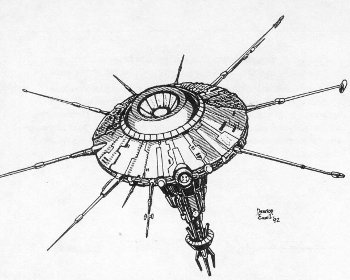
This is a satellite, I think?
Apparently there were about a 100,000 satellites previously in orbit, but a good number of those were wiped out. Scavengers search for old satellites, however, and many of those remaining have been captured or stripped. In addition, the stations have added their own satellites - mostly for communications, navigation, or surveillance, but more rarely new "killer" satellites have been added. Most combat satellites are used as part of the Earth Containment policy, but some are used to protect stations.
The basic satellite types are detailed in the book are:
-
Communications:
Not used so much anymore, as they largely were used for surface communications. The few new ones built are used to ensure station-to-station communications as well as communicate out to the Asteroid Belt.
-
Navigation Satellites:
These are both new and old satellites that are basically beacons for ships to orient around.
-
Sensor Station Satellites:
All the stations use these to monitor solar activity and ship movements, generally, though some are used to monitor Earth as part of containment.
-
Surveillance Satellites:
Most of these are old military satellites that watched the Earth or part of the S.D.I. program (which would actually go defunct a year after
Mutants in Orbit
was published). New ones are, of course, used as part of containment.
-
Defense Satellites:
These were originally built as a part of S.D.I., and, in a fit of "wait, what?!" were fitted with AI and self-defense systems, so these are basically the wandering damage of space. Oh, and all of them can self-destruct. They "communicate in a simple programming language similar to English", and can make basic logical conditions, and can be shut down with old commands. Or... "presented with a convincing, factual argument, can be persuaded not to attack."
 There are also those like kinetic kill weapons and "brilliant pebbles" that are basically rockets that activate and home in on targets. (This was a cutting-edge idea when
Mutants in Orbit
was published; the program, similarly, was cancelled two years later.)
There are also those like kinetic kill weapons and "brilliant pebbles" that are basically rockets that activate and home in on targets. (This was a cutting-edge idea when
Mutants in Orbit
was published; the program, similarly, was cancelled two years later.)
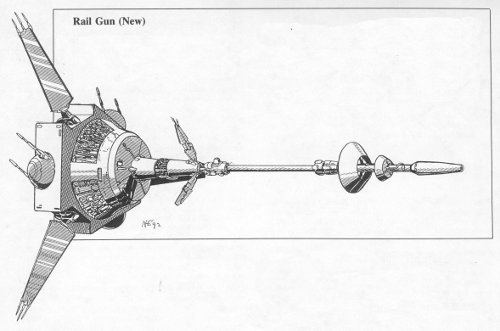
More evidence for the "bigger dick" theory of warfare.
Then we get stats for murdersats:
-
Old Kinetic Kill Rocket:
Does 3d6 M.D. For the record, medium-range missles have 10 M.D.C. (only a 62% chance of destroying it) and long-range missles have 20 M.D.C. (can't destroy it). As an S.D.I. missile defense system, this is a boondoggle.
-
Brilliant Pebbles:
The real "Brilliant Pebbles" were just kinetic-kill weapons like above; the
Rifts
version packs a nuke for good measure, and does the standard nuke damage in
Rifts
(4d6 x 10 M.D).
-
Rail Gun:
Does the standard
Rifts
rail gun damage (1d6 x 10 M.D.) despite weighing 2-7 tons.
-
Old Chemical Laser:
Now, real chemical lasers require chemical reactions to keep firing (hence the name) and thusly can run out of chemical "ammo", but this can just requires a recharge period. Why call it a chemical laser, then? No idea.
-
Old X-Ray Laser:
One of the most devastating weapons in
Rifts
, this uses a nuclear explosion to generate a beam of focused X-Rays, doing
2d4 x 100
. Still not enough to likely take down a Glitter Boy... in any case, it includes the comment "You think it's a really stupid idea? These things exist! - James". Well, no, they don't exist, but the idea was tested by the U.S. military and discarded, probably because it's a really stupid idea. Sorry, James.
-
Standard Laser: Does less damage than a chemical laser, but doesn't need to recharge.
-
Giant Free Electron Laser:
Does a nuke's worth of damage for whatever reason, unlike real free-electron lasers.
-
Particle Beam:
A mid-range death ray, not much else to day.
-
Mini-Missile Launcher:
Carries 24 mini-missiles and can fire up to 4 at a time. "Can be manually reloaded", presuming you can chat its AI out of murdering you, I guess. Mind, there's no satellites noted that carry
regular
missiles.
-
Basic Decoy Satellite:
This creates a "false radar image" that makes it look like a spaceship to attract missiles and pebbles.
-
Advanced Decoy:
As above, but with thrust systems so it can jet around and really fake its spaceship act.
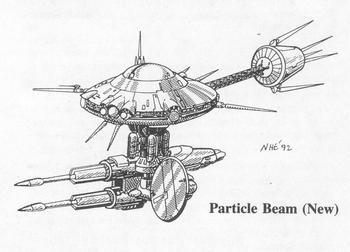
This satellite is known as "The Escher".
Also, a lot of these satellites have "NEW!" after their names, as if there had been old rules for satellites. It's a weird notation to make, and probably shows Siembieda's hand in the whole section.
Equipment
It refers us to other RPGs for equipment, noting that explosives are only delivered to miners, and only off-station, and that most space stations don't allow firearms, but melee weapons and their ilk are common. In addition, most people don't have access to energy weapons save for the military and the wealthy. It notes weapons costs "two to three times" more than their parent RPGs, and cybernetics and bionics cost 2-10 times as much. We also get a random "availability and cost table", which mainly jacks up the price by two to three times whenever you roll on it - it never makes anything cheaper, so it feels like a dick move for the GM to ever roll on it.
Special Weapons
Though weapons are illegal on stations, guards and military still carry them, and a lot of folks carry them outside of stations. There are key requirements most spacers look for: a lack of recoil (for zero-g) and weapons that don't blow holes in stations or ships. They key weapons are:
-
Laser and ion weapons:
These are ones designed to just boil and detonate flesh, but only do half damage to inanimate objects.
-
Dart pistols:
These are basically gauss guns that fire a poisoned dart. "They are virtually silent", which I guess makes them subsonic. Non-M.D., so don't fire them at a mutant bug or dragon.
-
Recoiless weapons:
These are standard guns that have no recoil because... they're made out of ceramics or plastic? Uh. Physics failure. It is possible to have reduced recoil weapons, but through other means that actually make sense. Granted, most of those aren't terribly practical, which is why they're so rare. A lot of folks use rubber bullets in stations, though
Rifts
has explosive rounds that let them do a dinky 1d6 M.D.
-
Fletchette weapons:
These actually fire explosives that somehow deliver a bunch of tiny shards to one target in one shot. I'm confused by how this is supposed to work, but whatever. The book has steel shards (stabby damage), magnetic particles (impair vision and works like a tracer), explosive phosphorous (you're on fire), poison (mild disorientation), and tranquilizer (knocks a person out, maybe). None of these do M.D.
-
Gas grenades:
Like it says on the jam tin. The book has smoke, stun (actually knockout gas), tear gas, and flash (actually a taser) grenades listed. It notes "none of these grenades work in a vacuum" which I think they actually mean work
well
.
Other Weapons
Being a Rifts book, the weapons go on:
-
Chemical Laser:
Does marginally above-average damage for a rifle. Once again, the chemical nature of the firing system is ignored.
-
Railgun:
It has serious recoil, and there's some basic rules for that. It's a low-damage rail gun, otherwise.
-
Jet Pistol:
This isn't used for combat, but instead to propel yourself in space if necessary.
-
Rocket Flare Pistol:
"... visible to the naked eye for up to 3200 miles..."

And we get an equipment list, including:
-
Manned Maneuvering Unit (MMU):
Like real astronauts use, even 300 years later.
-
Magnetic Shoes:
Will stick onto metal floors or walls.
-
Mini-Disk:
"A small, one inch, silvered disk is used to record and store computer information. Each mini-disk can store up to 100 megabytes of information."
-
Rescue Sphere:
An infatable ball that can save you from the vacuum of space, with enough air for ten minutes, "although an auxiliary oxygen pack can be fixed to the outside for a much longer period of air." Doesn't do you much good once you're
in
one, mind...
-
Vacuum Suit:
Apparently the ones from before the
Rifts
are your standard suits we know from the real world. See, this is dumb, but I'll get to that later. There's also an emergency survival suit and a fitted modern suit with 20 M.D.C. They can also have a jet pack attached that's way beter than the one listed above, or an exoskeleton that gives you a Physical Strength of 30. Lastly, they can have a recycling system that "recycles all oxygen, meaning it can be worn indefinitely". I'm not sure that's possible, but sure. We already have giant bugs that breathe carbon dioxide, why not an infinite oxygen supply?

This is mostly redone from other Palladium books - new stuff includes... an alarm eye! Replace your eye with an alarm that goes off when you see something (even when you're asleep, somehow, maybe you had your eyelid removed too?). A clock eye so you always have a clock in your visual field! A database that scans things! A fletchette hand that shoots fletchettes! A grapple hand that can't be used to hold things but can grapple things (the Bionic Commando tradeoff, I guess). A remote control hand that can run around! A micro-manipulation hand that adds to your Physical Prowess when doing fine work (even though that stat does not play into such rolls at all). A "dataplug" so you can go "cyberjacking". An oxygen recyler that reduces your oxygen intake. Hardened circuits that protect you from EMP weapons that really aren't even covered in the game! Whee!
One last thing I'll mention is a real issue with equipment sections like this. See, originally they were written for After the Bomb , which is a post-apocalypse setting that occurs decades after an atomic war, so the idea of having contemporary spacesuits and other technology makes sense. But in Rifts , which was supposed to have a high-tech "golden age" about two centuries after the present day, it just doesn't work. Of course, there's no acknowledgement of this contradiction in timelines, and so things get a bit goofy.
Next: The
It doesn't even phase him that he cannot actually control the insects and that they would destroy him in an instant.
Original SA post
It's time to take my rifle and this review back behind the shed.

Rifts® Space Part 9: "It doesn't even phase him that he cannot actually control the insects and that they would destroy him in an instant."
Space Adventures
Most of these adventures are for
After the Bomb
, so I'm going to skip them. They're written by Wallis and are actually pretty extensive... it says you can modify them for
Rifts
, and to some extent that's true, but doing so is beyond the scope of a review like this. So I'm skipping them, even though one of them has a spaceship named the
Pooh Jihad
.
Instead, it's time to cover the one adventure that is written for
Rifts
, "A Visit to an Unfriendly Planet". First off, the PCs wander into a town and discover that giant mutant insects are attacking a small community, and go fight them to the death. Now, the matter of mutant insect PCs has been hinted at but not broached, but here it says:
Mutants in Orbit posted:
Note: At the GM's option, this could be a good time to introduce any player characters or a friendly NPC. Remember, insect characters will have a low I.Q. and react on instinct more than anything else.
Which contradicts the previous bits that portrayed them as killer remorseless eating machines, but honestly it would be more interesting to have some nuance to them than just being big bugs with thumbs.
So the locals tell the PCs that an insane shifter is responsible for the bugs. Apparently he's a local named "Mage William Targturn" or "Mage Targturn", who helped to build and protect the town, but has become megalomanical and insane... because the Splugorth drove him crazy and made him evil!... somehow. He's all hopped up on goofballs and ale these days, and often picks fights with people, sometimes murdering them. Oh, and sometimes he lets demons loose for no particular reason. Basically, he's a tremendous cocktip. Two months ago he showed up claiming he'd finally get revenge, being unspecifically crazy, and how he'd summon the perfect army to take over the world. Which is a little confusing, since it's clear the villagers can't stop him - why hasn't he just thrown fireballs at them until they're dead? Well, like I said, he is generically mad. Shortly after that giant bugs showed up, and they're pretty sure this is his "army".
The next section is entitled "game master information" (what, the first part was to be read by the players...?). Basically he's discovered a rift to Mars. He plans to use summoned demon slaves (there are no Shifter spells for enslaving demons) to bring insects to Earth. The book points out he has no actual means to control them and they'd probably just eat him, but once again, he's crazy. Anyway, the PCs bust into his tower, kill some demons and bugs, and then find the rift, which sucks them in automatically. There, they end up on Mars, fight some bugs, and then it tuns out Targturn's telepathic powers (not previously mentioned) have mutated (no reason for mutation is given) so he can mentally control bluebottle bristle flies. Wait, didn't it just say they would eat him? Make up your fucking mind, Kevin!

And so the PCs have to kill him and close the rift. It's unlikely they can do the latter, since Close Rift is a 14th level spell requiring 200 P.P.E. (and a small permanent sacrifice of the PC's total P.P.E.). Thankfully, there's a low level shifter who studied over Targturn who can do it for them. Despite being low level, he can cast a 14th level spell somehow, and apparently was just sitting on his thumbs the whole time while his teacher terrorized the populace. Way to go, cowardly and gutless nameless low level shifter!
Mutants in Orbit posted:
Objectives: 1. Kill the shifter. 2. Return home and seal the dimensional portal. 3. Others...
... there are no other objectives.
We then get Rifts adventure ideas!
-
Things from the rifts come out and cause trouble.
-
Travelers from the rifts come out and cause trouble. Or maybe they don't.
-
An alien menace is found floating in space and brought back to a station. It causes trouble.
-
Yuro or Outcast Station are full of jerks who might be plotting something... and causing trouble.
-
Mutant insects are brought back to a station and cause trouble. (It notes the Splugorth might want some.)
-
A evil superbeing team might cause trouble.
-
Superhumans can always cause trouble.
Speaking of holding your breath, we've reached the end of
One last note: you may be wondering - why didn't this book warn you about violence and the supernatural , or parental discretion ? Well, as an After the Bomb book, there's no such warning!
 I didn't skip it. To be fair, it's much more tame compared to something like
Rifts World Book One: Vampire Kingdoms
and its human blood farms.
I didn't skip it. To be fair, it's much more tame compared to something like
Rifts World Book One: Vampire Kingdoms
and its human blood farms.
See you, Space Glitter Boys.
Next: A small preview of my next F&F disaster to come:
